There’s one flying machine that demands all to stop in their tracks, regardless of whether they care about flying or not. That’s the iconic Goodyear Blimp, and for the past 100 years, these massive airships have captured the imaginations of millions of people, distracted spectators at sporting events, and shut down small towns. Many folks have “ride in the Goodyear Blimp” as a dream, and that included me. I got the rare chance to fly in a Goodyear Blimp, and it was such a different kind of fun experience, it’s going to be hard to beat. I also learned that blimps don’t work how I thought they did.
Airships are products of a bygone era of aviation. The airships of today are often used as large advertising vehicles and are sometimes pitched as giant cargo carriers or research craft, but wind the clocks back a century, and the anticipated future of the airship was very different. Back then, airships were treated like gigantic flying ocean liners and flew people to far-flung destinations. The airship was innovative, too. History celebrates the Wright brothers for their first powered flight of an airplane in 1903. Yet, there had been powered, controllable airships for 51 years before the brothers flew into the history books.
The Goodyear Tire & Rubber Company has been deeply involved in airships for over a century and has produced some of the coolest airships in history, including the USS Akron flying aircraft carrier and over 210 other airships for the United States Navy. Yet, Goodyear’s most iconic airships are its advertising blimps. The company built its first blimp in 1925, and Goodyear is celebrating a century of floating through the skies this year. Goodyear currently flies three blimps in America and brought two of them, Wingfoot One and Wingfoot Two, to EAA AirVenture Oshkosh 2025. While the public frequently gets to see these airships, relatively few people ever get to fly on them. I was graciously granted such an awesome opportunity, and it was dream come true.
The Legend Of The Airship
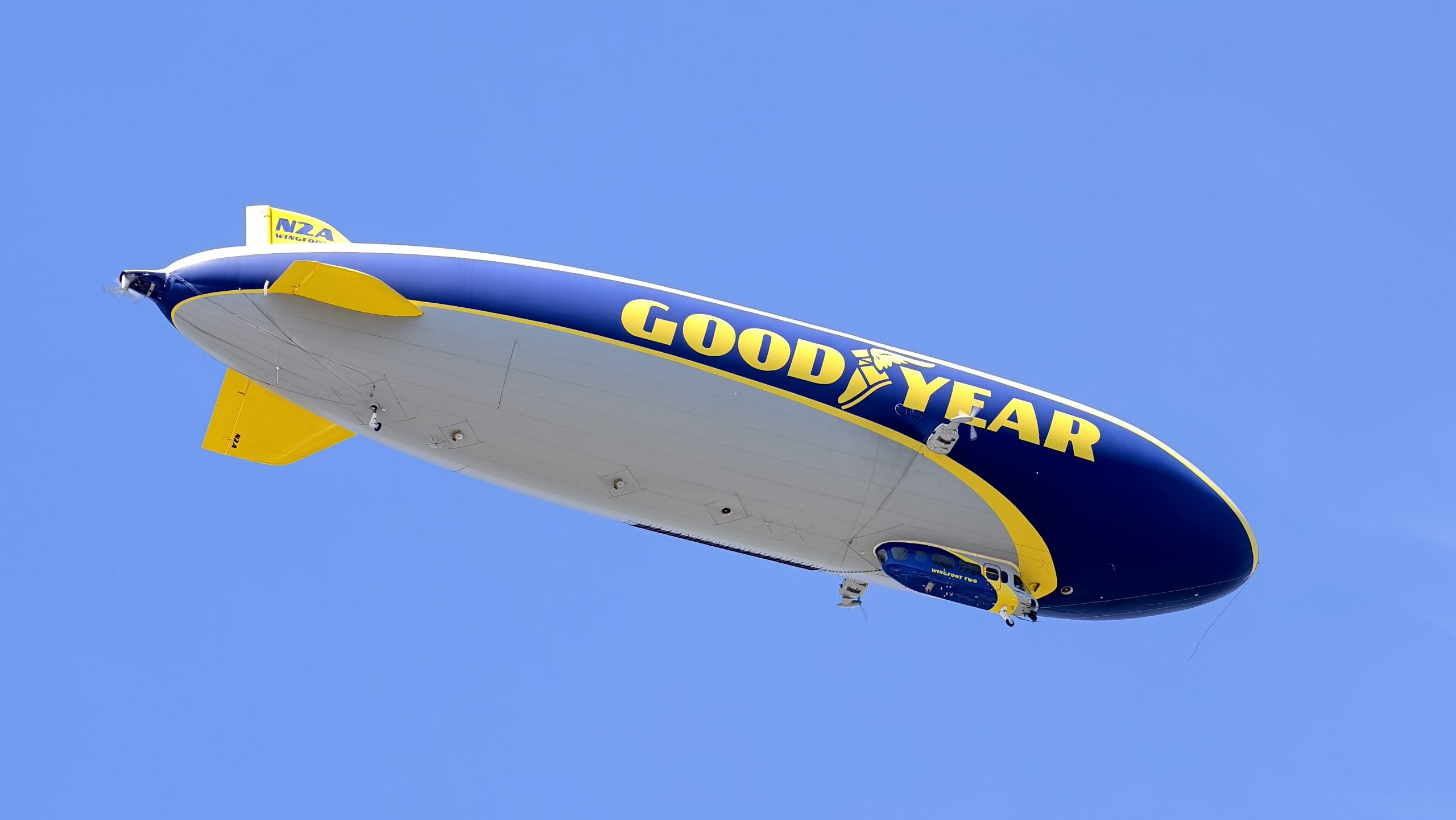
Airships have been captivating the minds of people for centuries. In 1670, Francesco Lana de Terzi penned what could best be described as an aerial ship, though such an invention was never made. In 1709, priest Bartolomeu de Gusmão demonstrated a model of an airship to King John V of Portugal. Then, as Space.com writes, Joseph and Étienne Montgolfier made the world’s first hot air balloon flight on September 19, 1783. Balloons were magical in how they lifted people from the Earth to be carried to a destination, but right from the start, balloon aviators were frustrated that balloons sort of just drifted wherever the wind took them.
Inventors had certainly tried. Space.com details the airship designed by General Jean Baptiste Marie Meusnier in 1784. His design called for an airship measuring 260 feet long and propelled by three propellers that would have required 80 men to operate. This airship was never built.
Then there was Pierre Jullien of Villejuif, who in 1850 demonstrated a flying model of a powered airship. Two years later, Jules Henri Giffard flew into the pages of history when he took Jullien’s idea and turned it into a full-size powered airship. Giffard’s airship looked like a cigar and stretched 143 feet long. A 3 HP steam engine provided propulsion, and on September 24, 1852, Giffard’s airship flew 17 miles at 6 mph. The era of powered airships was on.
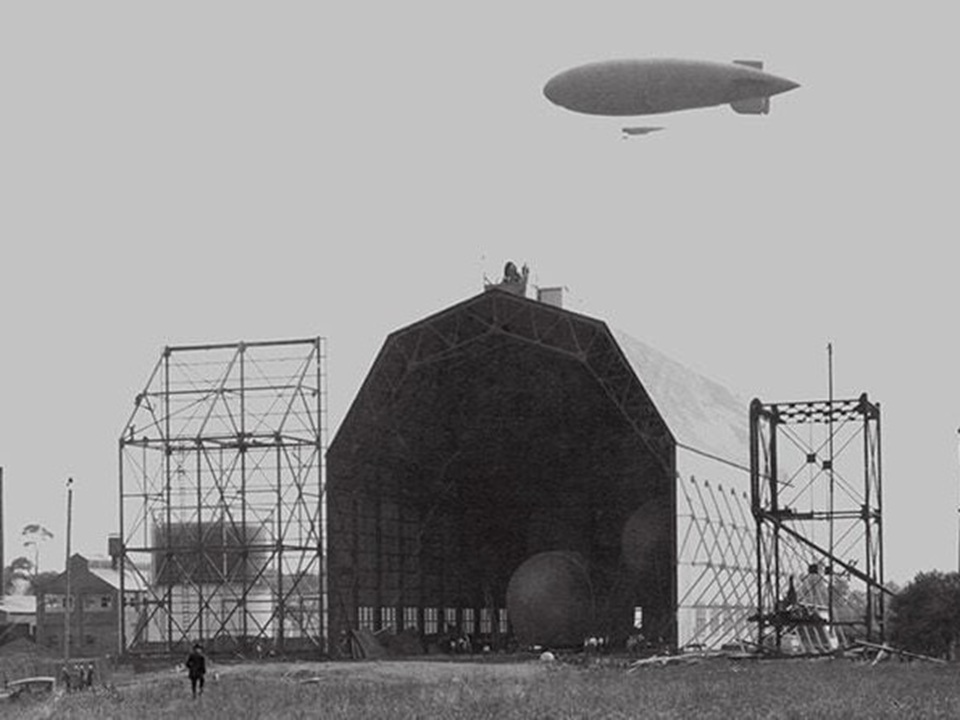
The Goodyear Tire & Rubber Company says it got into aviation in 1910, during the pioneer era of fixed-wing aircraft:
The Goodyear Tire & Rubber Company’s Wingfoot Lake Airship Base, located near Akron, Ohio and sometimes called “The Kitty Hawk of Lighter-Than-Air,” is the oldest airship base in the United States. Goodyear entered the fledgling aviation industry when it established its Aeronautics Department in 1910 to market rubber-infused fabrics and coatings for airplanes and lighter-than-air craft. Goodyear built its first balloon in 1912 and the next year began building and flying balloons in national and international competitions. In 1916, Goodyear bought 720 acres of land southeast of Akron to serve as a flying field and manufacturing site. It included Fritch’s Lake, which provided water power for a grist mill and a water reserve for factories several miles downstream. Construction of the Wingfoot Lake hangar started in March 1917. The facility and the lake itself were named after Goodyear’s corporate emblem, the winged foot of the Roman god Mercury.
Goodyear’s first airship production began in March 1917 when the U.S. Navy ordered nine B-type airships. Since the hangar at Wingfoot Lake was still under construction, the initial prototype, the B-1, was erected in a large amusement park building in Chicago. The B-1 first flew on May 24, 1917. Five days later, it was flown nonstop to within a few miles of Wingfoot Lake. Although most of the B- and C-ships built by Goodyear were shipped to the Navy for final assembly and flight testing, Wingfoot Lake was used as the training site of the first class of Navy airship pilots. With Goodyear personnel as instructors, some 600 Army and Navy officers and enlisted men were trained to fly and maintain B- and C-type airships, kite (observation) balloons and free balloons.
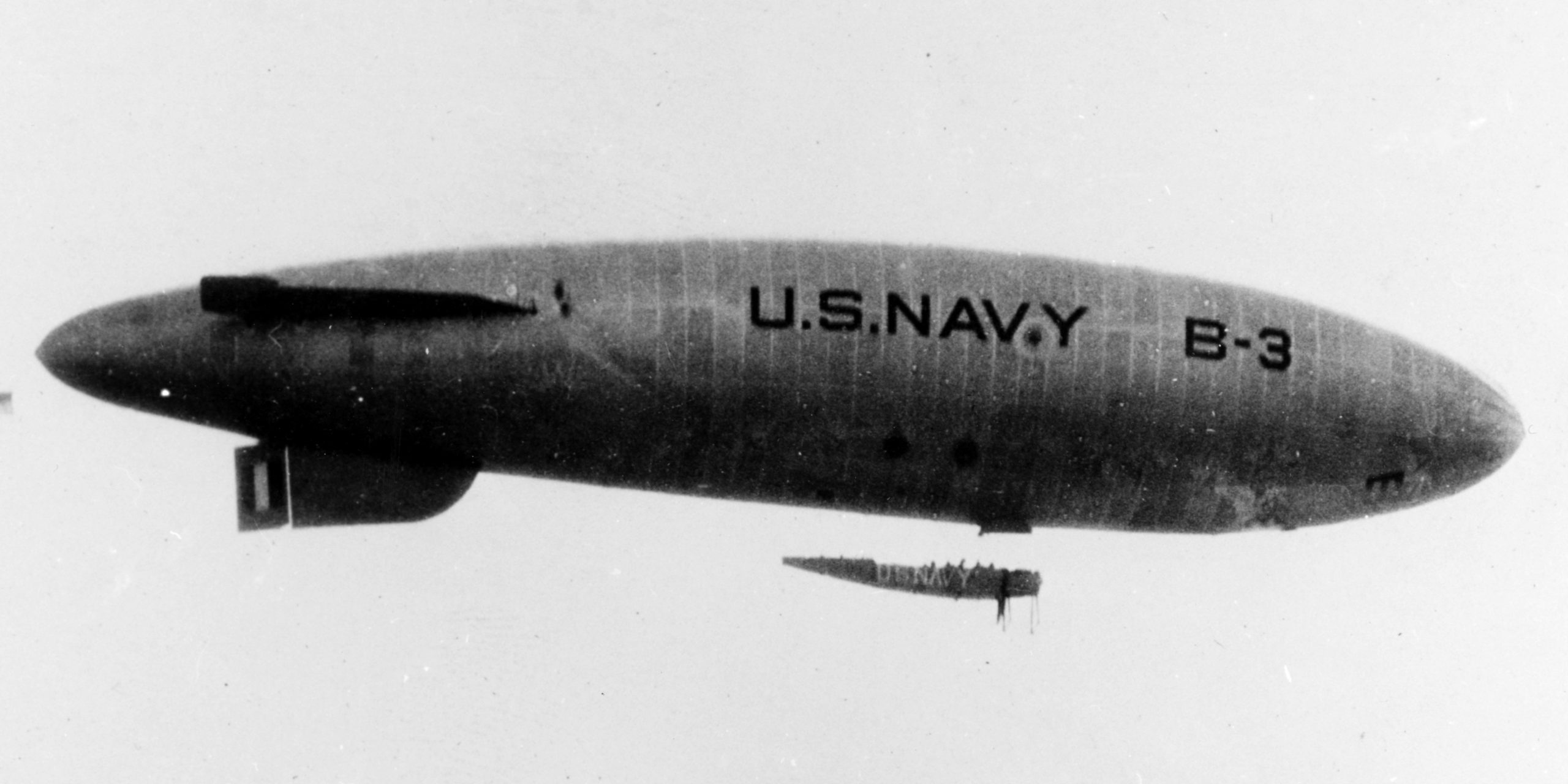
The First Goodyear Blimp
Goodyear says that the U.S. Navy took over Wingfoot Lake in 1917 and operated it as a training station until 1921. One of the company’s biggest advancements happened in 1925 with the launch of Pilgrim, the first Goodyear Blimp.
Here’s where I must take a small detour. You might be wondering why Goodyear is saying that its first blimp was the Pilgrim when it clearly built airships before this. Well, that comes down to how airships are classified. All blimps are airships, but not all airships are blimps. The airships that we call blimps are known as non-rigid airships. These airships rely entirely on the gas in the envelope to retain their shape.
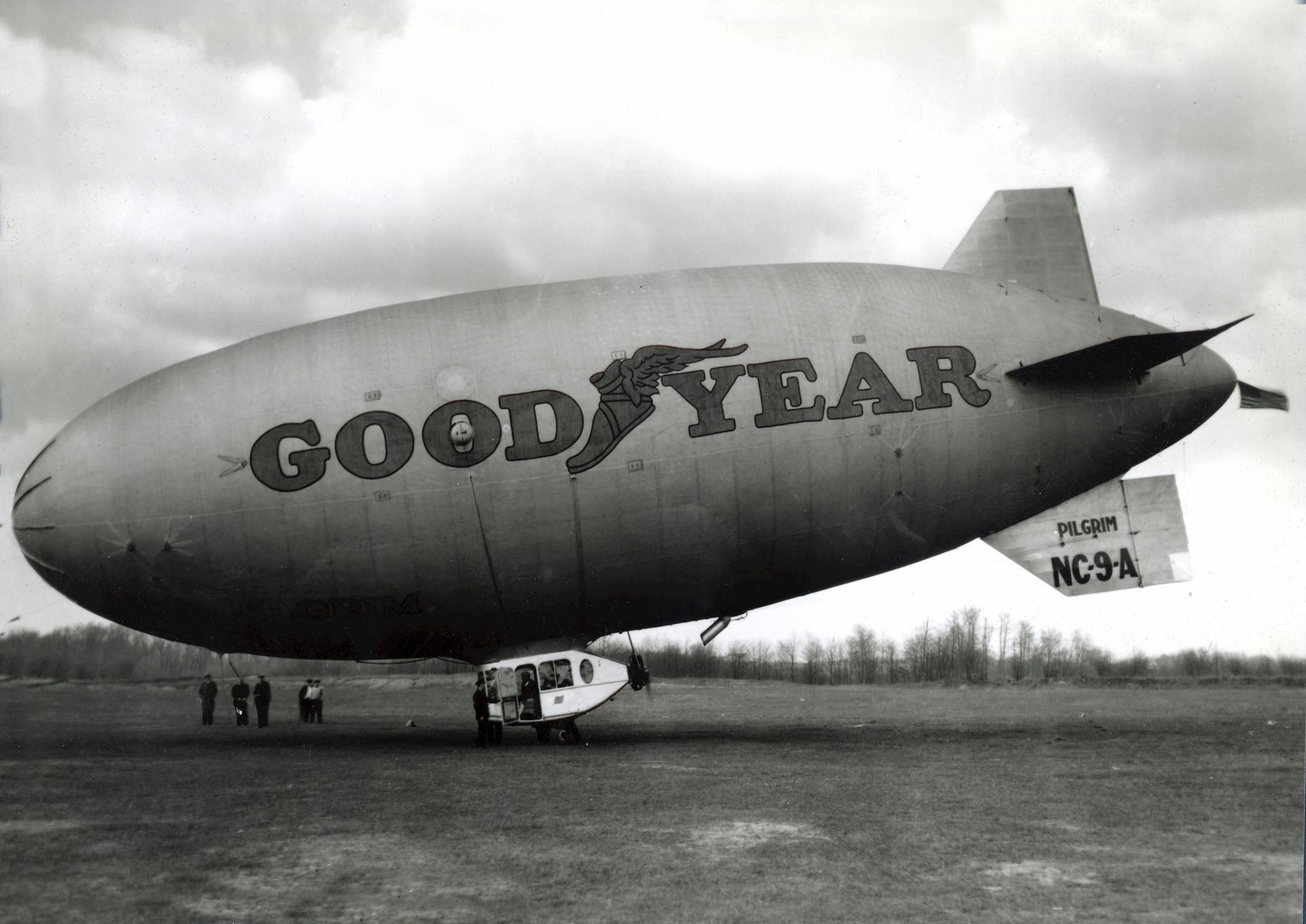
From there, you have the semi-rigid airship, which uses some supporting structure in its envelope, like a keel, to help the envelope keep its shape. However, in this design, the lifting gases still do substantial legwork in maintaining the airship’s shape.
Finally, there’s the rigid airship, and by now you can guess that these airships are built with superstructures. Now, the envelope has a rigid framework and wears a skin. Lift is achieved through large gasbags inside of the structure. Most of Germany’s colossal Zeppelins were rigid airships. Just like how all blimps are airships, but not all airships are blimps, not all airships are Zeppelins, either.
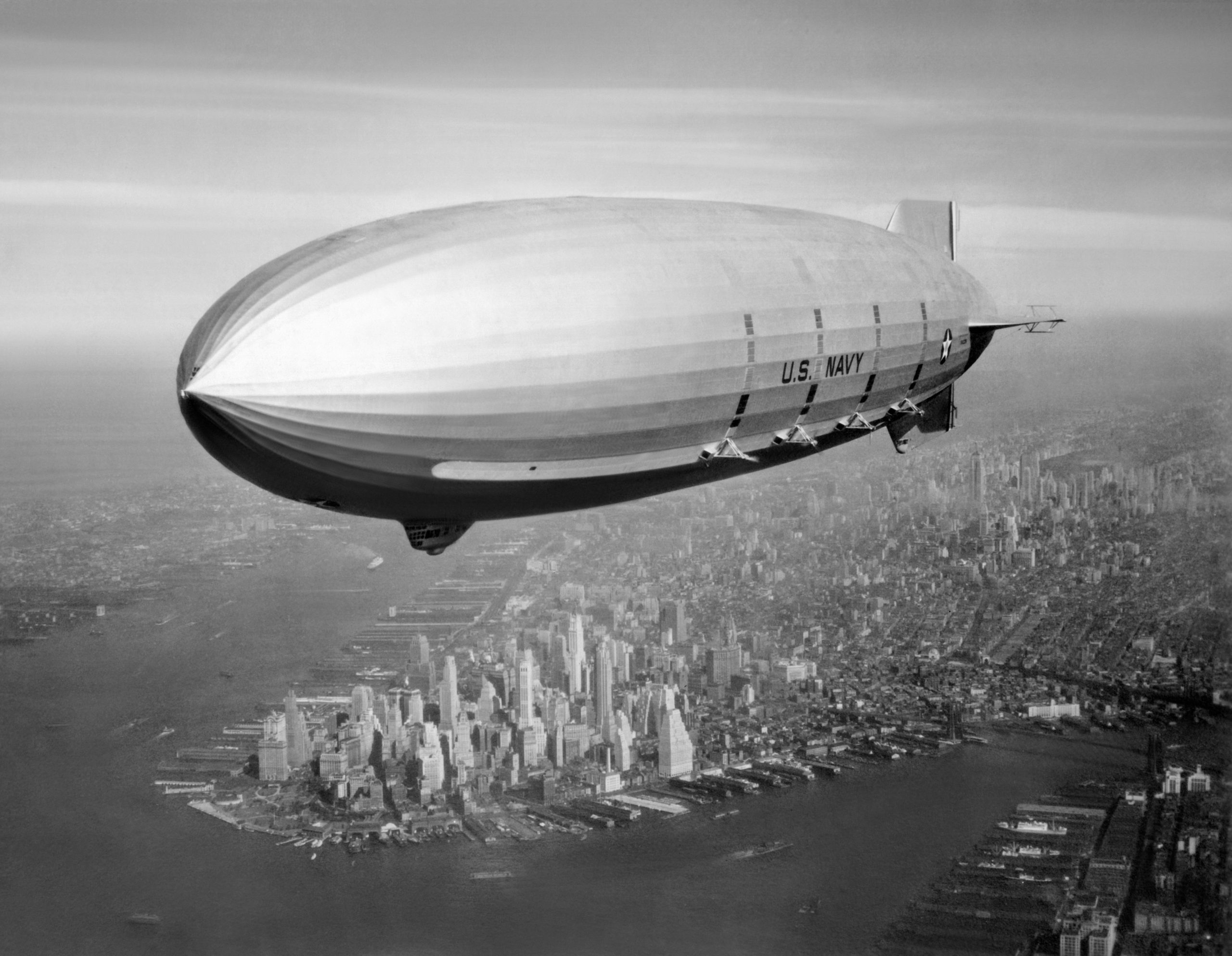
While I’m on this subject, I’ll mention a few other things you need to know. Airships are known as dirigibles, which means a powered, maneuverable lighter-than-air craft. You’re probably wondering why specifically non-rigid airships are called blimps. You’re also probably wondering about where “blimp” even comes from. Well, as the National Air & Space Museum notes, the origin of the term isn’t fully known, but there are good theories:
Pressure airships are commonly known as blimps. The origin of that term has caused a good many arguments. One story relates to an English officer, Lt. A.D. Cunningham, RN, who entered a hangar containing a pressure airship in 1915. He was unable to resist plunking his finger on the gas bag, which produced the sound “blimp.” By noon that day his mess mates were applying the word to their gas bags. Another accounts claims that Horace Short, the famous British aircraft builder, took one look at an early Sea Scout airship, with a B.E.2C airplane fuselage hanging beneath a gas bag, and immediately dubbed the thing a blimp, commenting, “What else would you call it?”
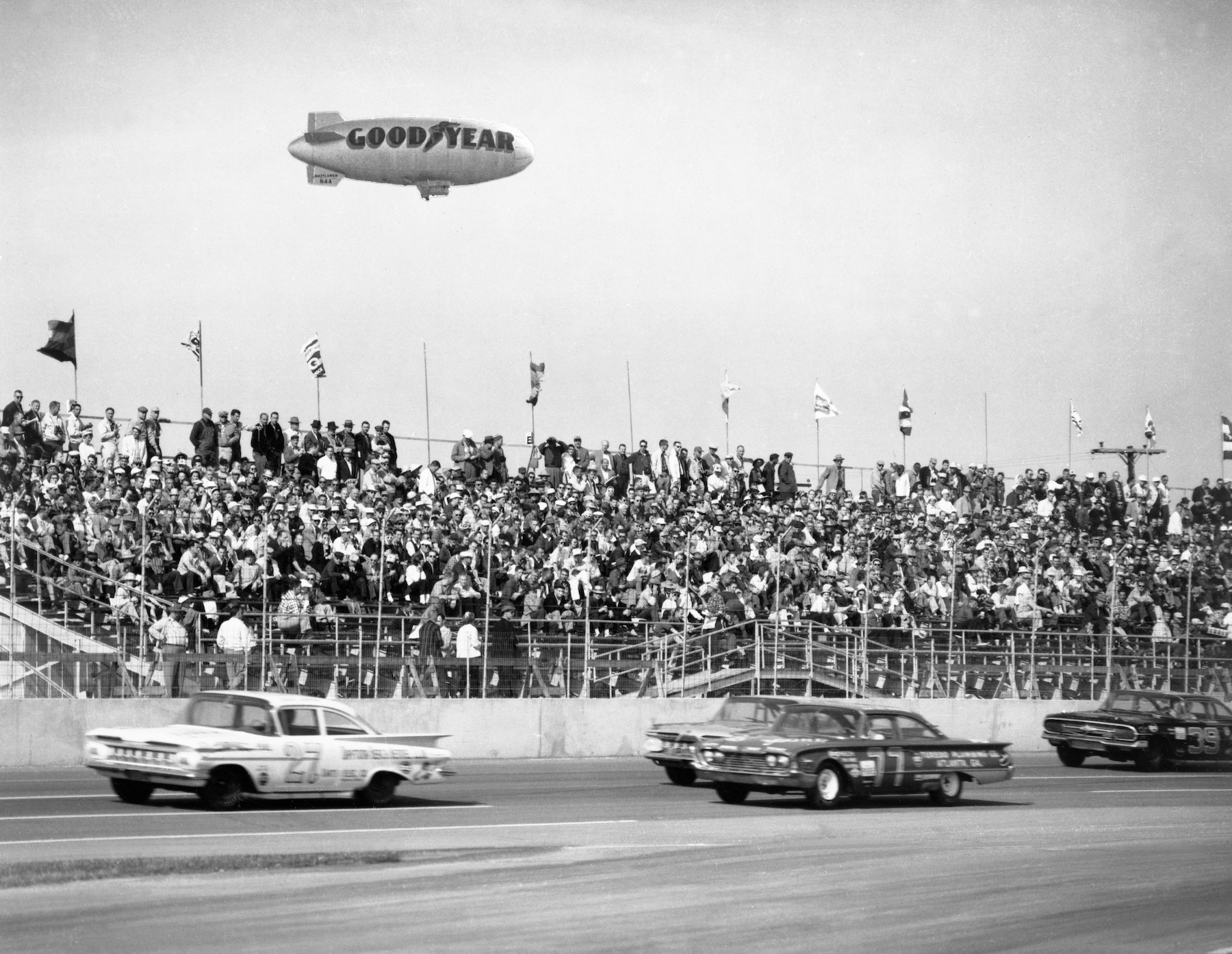
This is why Goodyear says that its first blimp didn’t come until 1925. As for that blimp, Goodyear gives us details:
Goodyear’s Pilgrim was the first commercial non-rigid airship flown using helium. With a landing wheel replacing bumper bags and the first passenger car held flush against its bag by internal cables, the Pilgrim was at the top of LTA technology. Previously, blimp gondolas were suspended from their envelopes by external cables only. Pilgrim’s contribution to aeronautics is recognized by the Smithsonian Institution, which exhibits the airship as a milestone in aviation progress.
The Pilgrim was also the first Blimp to be used for public relations and was decorated each December for the company’s “Santa Claus Express” program. In 1930 the Goodyear Blimp Defender became the first airship in the world to carry a lighted sign. Developed by H. Webster Crum and named Neon-O-Gram, the sign was comprised of ten removable aluminum-framed panels, which were attached to the side of the Defender and allowed static text to be displayed using neon light tubes. Each panel weighed 35 pounds and stood six feet tall and four feet wide.
The fleet ships, Columbia, and Resolute were built with 112,000-cubic-foot envelopes in 1931 and 1932. The other ships in the fleet were gradually fitted with new, larger envelopes. The Enterprise introduced the 123,000-cubic-foot envelope in 1934. Other ships were eventually increased to this size, as were the new ships such as the Rainbow (1939).
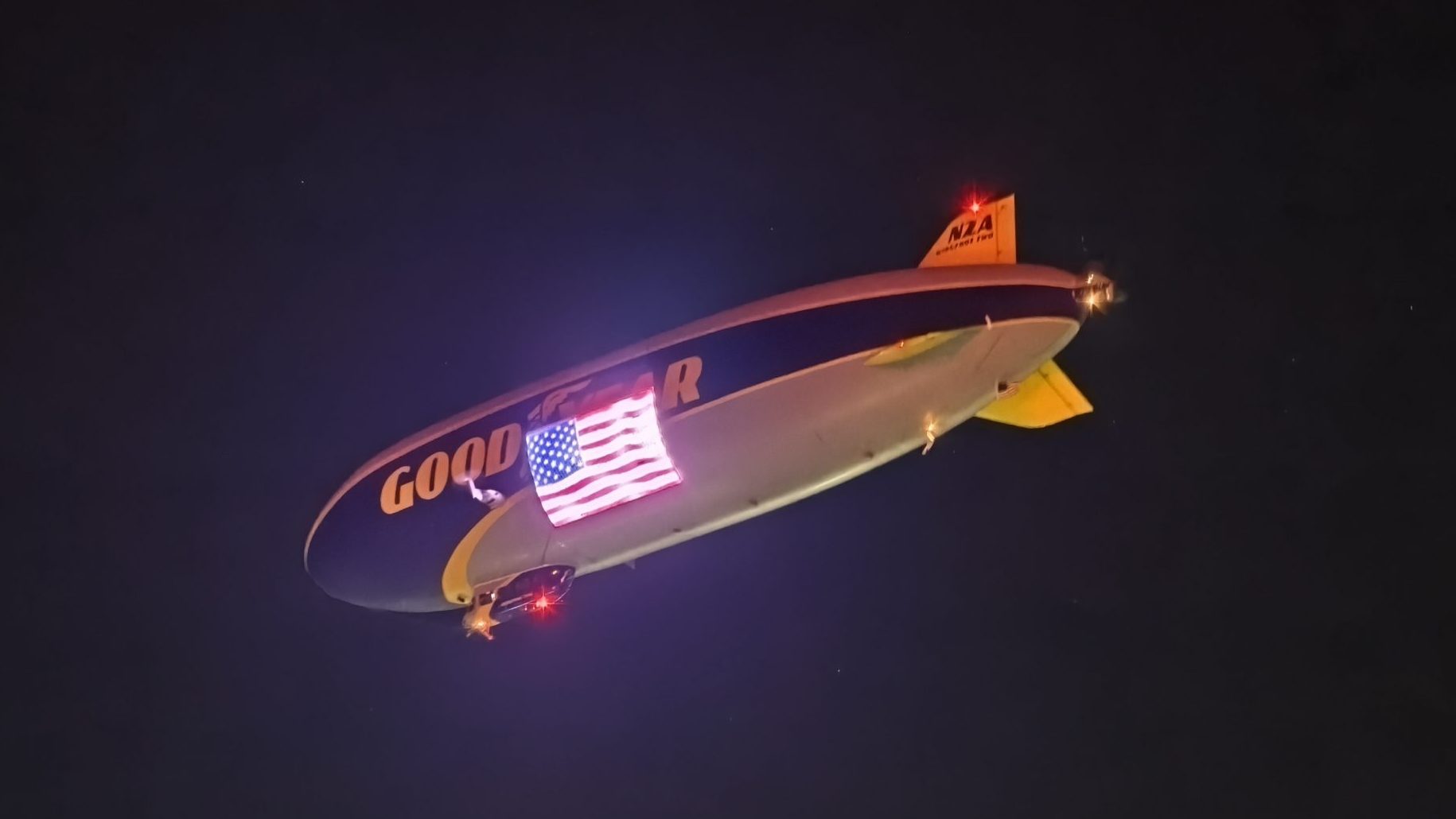
Goodyear notes that its commercial airships served a few clever purposes. Aviation was used for a lot of hijinks in the 1920s, including people walking on wings, aerobatics, acrobatic stunts, and more. If you were a young aircraft company, you did something huge and bombastic to advertise yourself. People got excited about the new world of aviation by watching pilots and performers execute death-defying acts.
Goodyear got in on the madness, not only to help it inch toward becoming a household name, but because the military was still highly interested in blimps, and Goodyear kept itself planted on the radar. Goodyear would later form the Goodyear Zeppelin Corporation as part of a joint project with Germany’s Luftschiffbau Zeppelin. This allowed Goodyear access to Zeppelin’s patents and engineers, and the new company constructed the mammoth USS Akron and USS Macon for the military.
Later, as conditions in Germany worsened in the time leading up to World War II, the division was spun off as the Goodyear Aircraft Company (GAC). Some folks know GAC best for its airships, but it also aided in the World War II effort with 4,017 FG Corsair fighter planes, the goofy amphibious Goodyear Duck, and the weird Goodyear Inflatoplane. Yes, that last one is as crazy as you think, and it was an inflatable plane.

Goodyear would build 152 airships to defend the Allies during World War II. These Navy blimps were great according to Goodyear because they were able to loiter above the ocean for extended periods to help be the seeing eyes for merchant ships crossing dangerous waters. Reportedly, none of the ships escorted by blimps were lost during the war.
In America, Goodyear’s blimps became icons. The Los Angeles-based Goodyear Blimp Volunteer flew Charles Lindbergh, made several visits to the Rose Bowl, and even flew over the 1932 Olympic Games. This blimp was also the first Goodyear Blimp to appear in a film when it landed on the silver screen in the film Hidden Valley by Monogram Pictures in 1932.

Goodyear’s blimps were total rock stars after this, with the company’s fleet flying over 42 states and later gaining technology like record players, microphones, and speakers to go with their lighting setups. Goodyear notes that while its blimps are no longer used for audio performances as in the past, the lighted signs became so popular that they’re still used today.
Sadly, as time went on, the advantages of airships as a mode of transportation wore thin as fixed-wing air travel improved with every year. Eventually, the Jet Age arguably made the airship obsolete as a form of travel. Even the U.S. Navy canned its airship program by 1960.
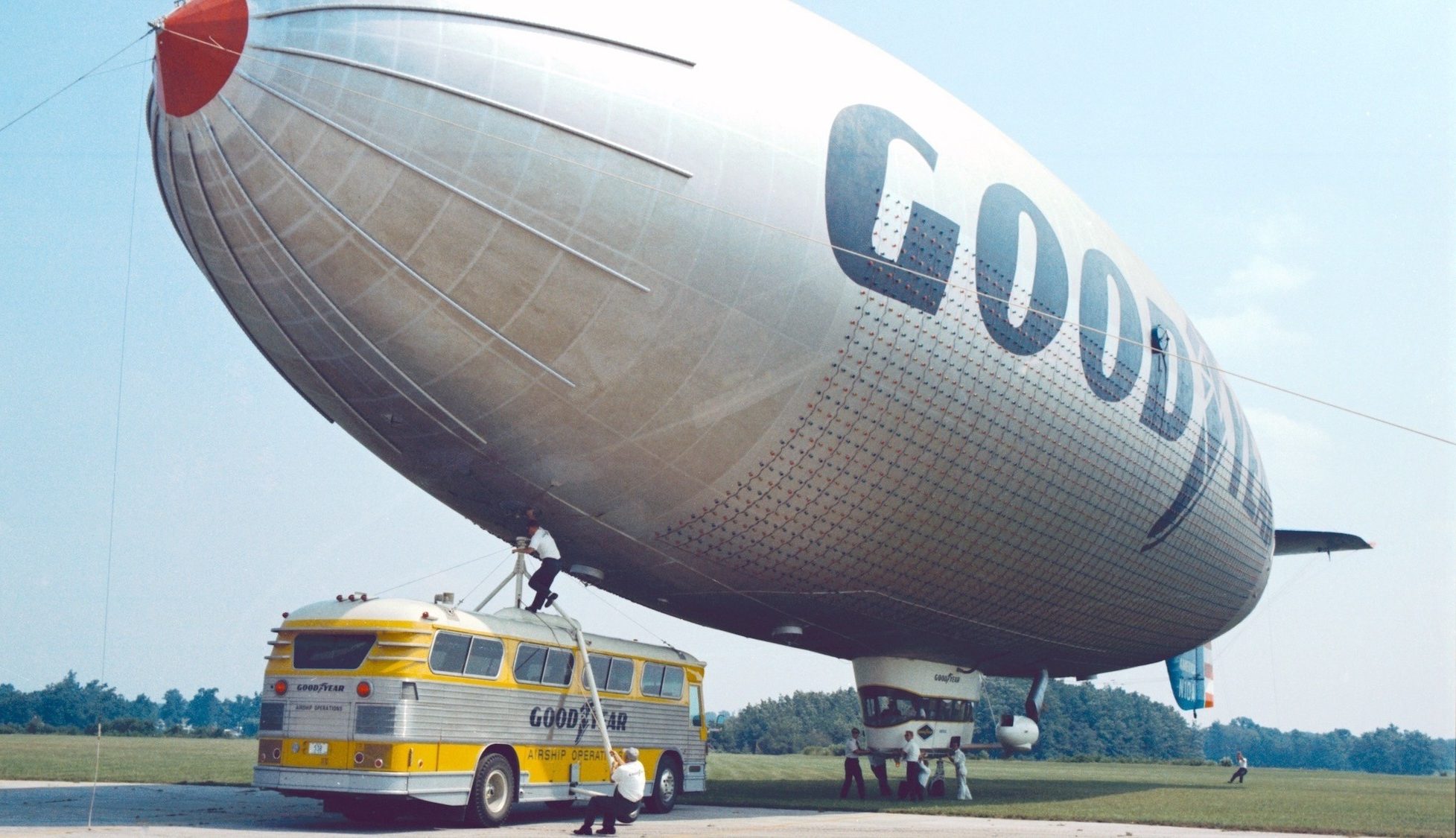
But Goodyear kept doing what it did best, and its blimps continued to entertain the public. Goodyear had figured out how to broadcast live TV on its blimps, developed new incandescent aerial sign lights, and even larger envelopes with greater lift capability. By 1966, Goodyear had introduced color signs onto its blimps. As the blimps got larger, the signs did, too.
Goodyear airships have even been used during emergencies, too. In 1989, Goodyear Blimp Columbia was doing its thing above Candlestick Park in San Francisco. Game 3 of the World Series between the San Francisco Giants and the Oakland Athletics was about to start when an earthquake measuring 6.9 on the Richter scale struck the Bay Area. Authorities asked Columbia to fly around and get views of the damage so emergency services could be dispatched to the areas that needed it quickly.

Goodyear Blimp Stars & Stripes responded to the aftermath of Hurricane Andrew in 1992 by relaying emergency messages from the American Red Cross in multiple languages. The company also says that its blimps have helped raise millions of dollars for, according to Goodyear, “Muscular Dystrophy, Toys for Tots, food banks, American Cancer Society, The American Red Cross, The Salvation Army, Support Our Troops, and many more.”
This is all to say that, wow, the blimps that fly over your favorite sporting events have a ton of history behind them.
Today’s Goodyear Blimps
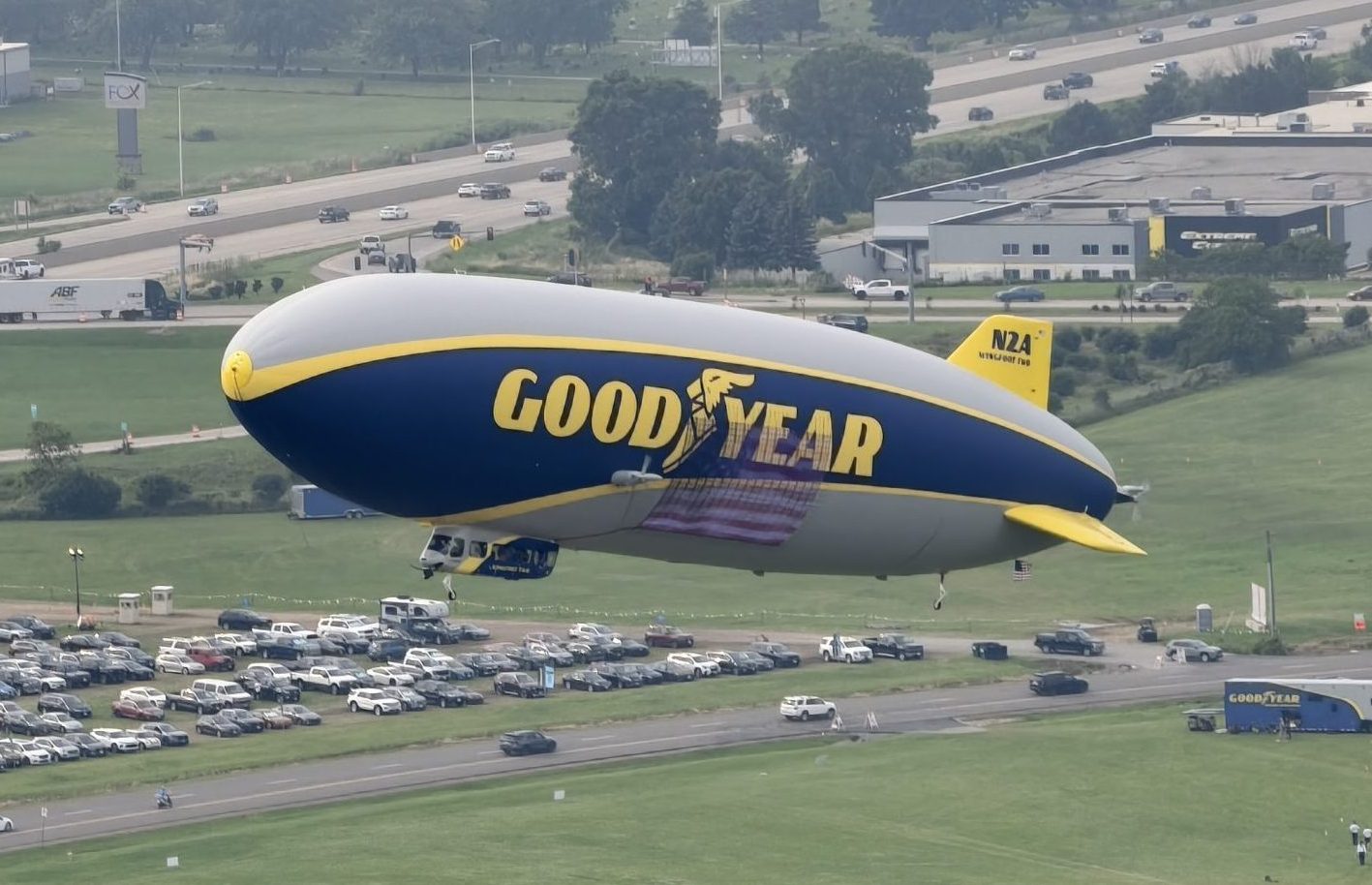
Today, Goodyear flies three blimps in America: Wingfoot One, Wingfoot Two, and Wingfoot Three. These airships are an interesting turn for Goodyear because while the company still calls them blimps, they are actually semi-rigid airships.
These new blimps are based on the Zeppelin NT (Neue Technologie) design by Zeppelin Luftschifftechnik (ZLT). This company is a spinoff of Luftschiffbau Zeppelin, which had been dormant for nearly 50 years when it was revived in 1993. The refreshed company sought to secure the future of the Zeppelin by using modern construction and material sciences.
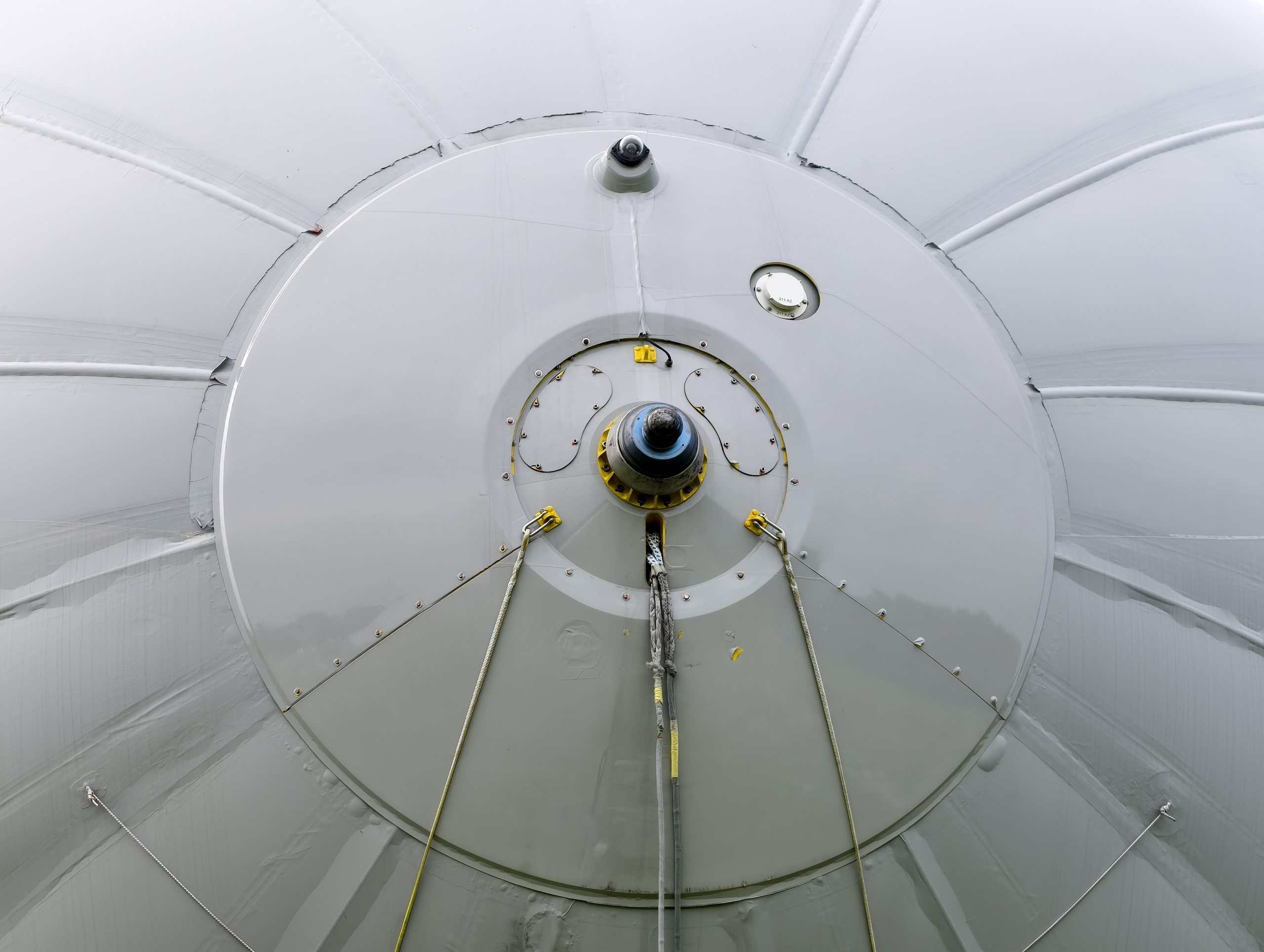
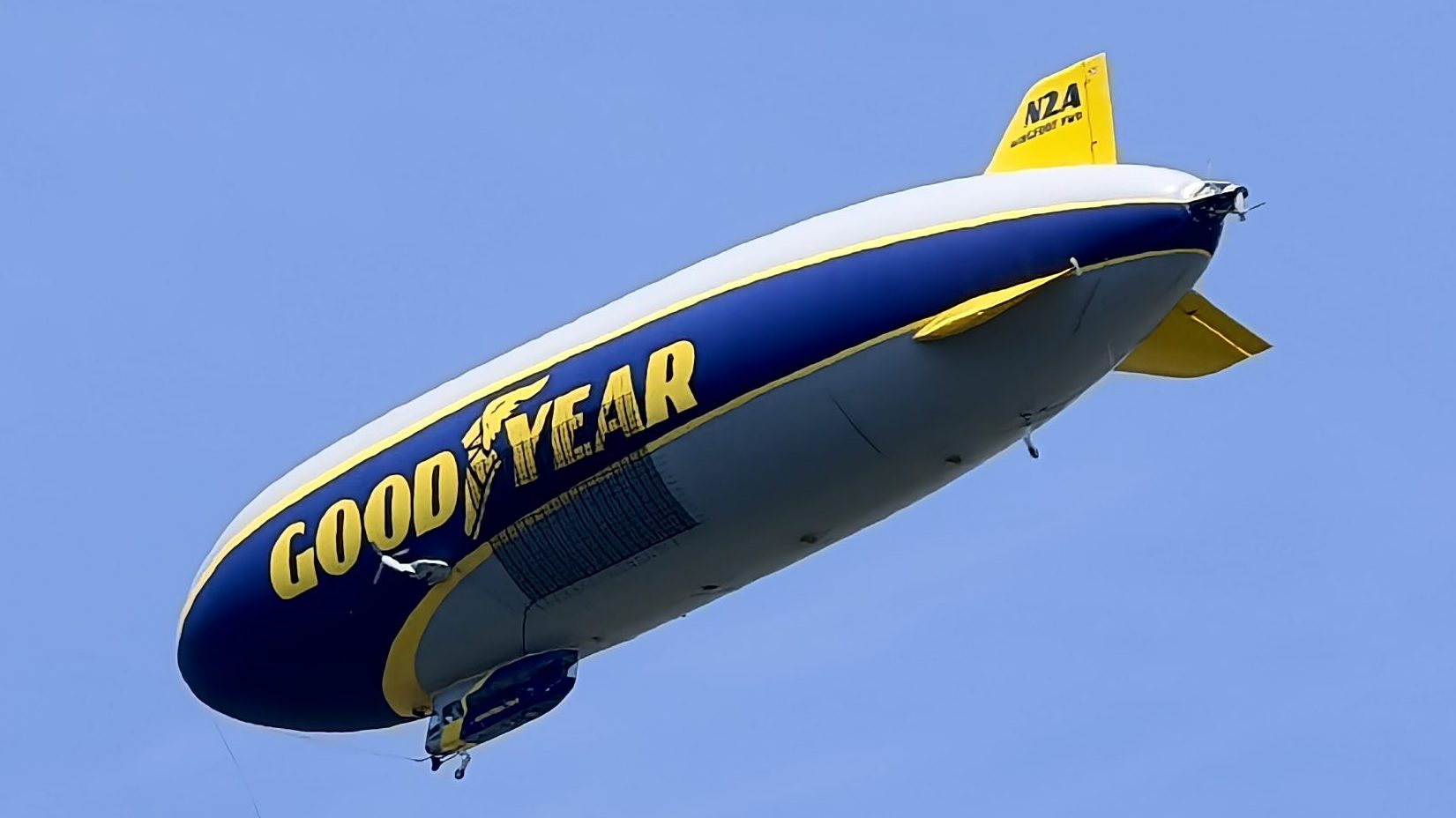
The Zeppelin NT took its first flight in 1997, and despite the vintage looks, these are thoroughly modern craft. Zeppelin NTs feature an internal 12-rib framework within the main envelope that’s built out of aluminum and carbon fiber. Goodyear says this allows Zeppelin to mount the engines high up on the envelope, which has the dual effect of quieting down noise for passengers while upping maneuverability.
Further, Goodyear says the gondola is made out of carbon fiber. It carries up to 12 passengers and two crew and weighs just 2,626 pounds, 800 pounds lighter than Goodyear’s previous generation blimp. One neat addition to the Goodyear NT blimp series is the first bathroom to ever be featured on the Goodyear Blimp.
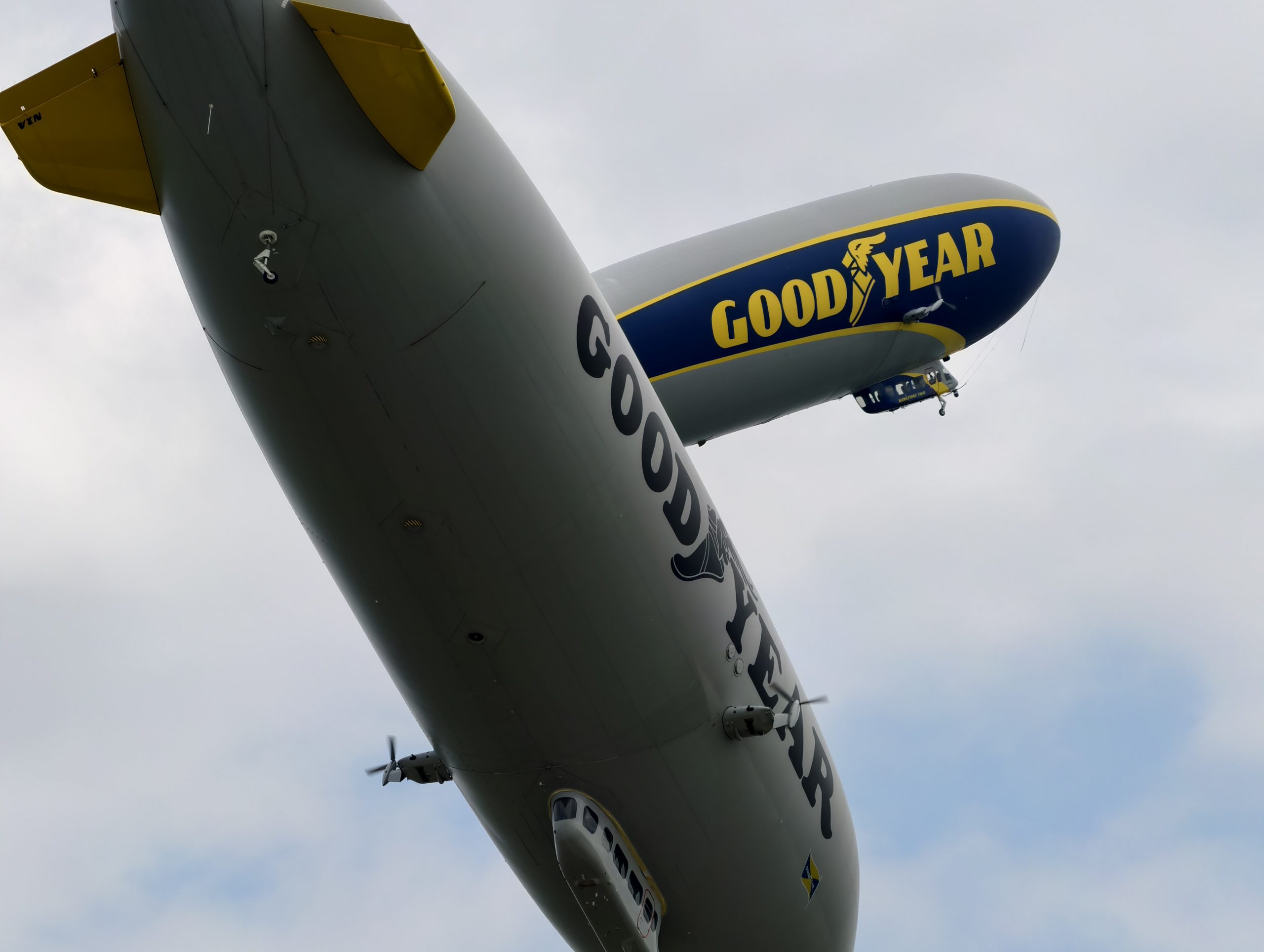
Other neat facts about the Goodyear NTs include how they’re 246 feet long – nearly the length of a Boeing 747-800 – and hold 297,527 cubic feet of helium gas. These giant airships, which are far from the largest ever made, weigh around 20 tons when they don’t have lift gases in them.
Power comes from a triplet of Lycoming IO-360 air-cooled 5.9-liter flat-fours good for 200 HP each. These engines have vectoring capabilities to help the blimps take off, land, hover, and maneuver. Goodyear’s current blimps cruise at around 40 mph and have a top speed of around 73 mph.
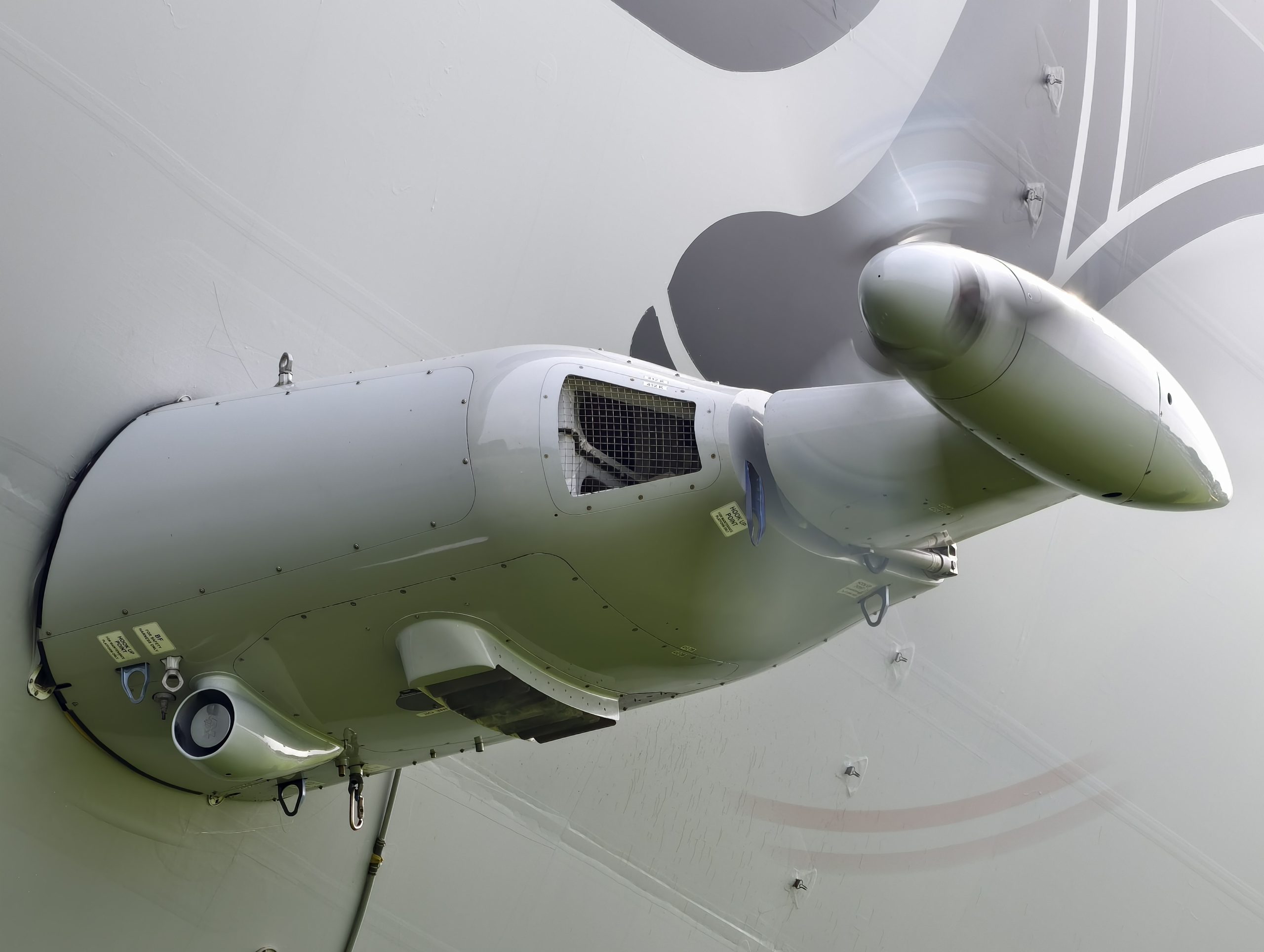
Goodyear says that its first Zeppelin NT, Wingfoot One, was built in 2014. Its next sibling, Wingfoot Two, was built in 2016. Finally, Wingfoot Three was built in 2018. Wingfoot One is stationed near Akron, Ohio, while Wingfoot Two lives near Fort Lauderdale, Florida, and Wingfoot Three is stationed near Los Angeles, California. There’s also a fourth blimp that Goodyear operates that’s stationed in Germany.
Flying In The Goodyear Blimp
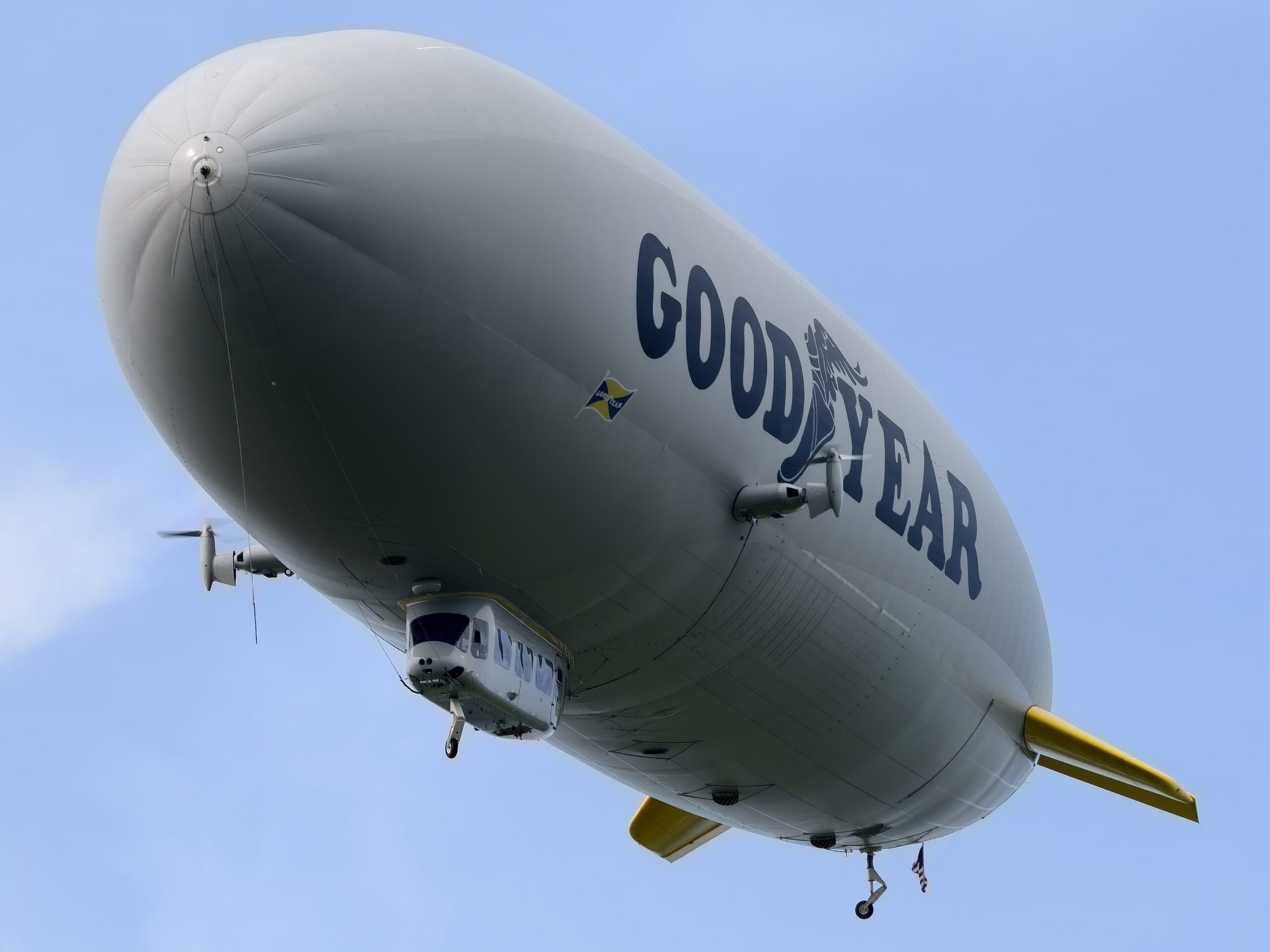
Goodyear is celebrating 100 years of its blimp operations this year and decided to spread the joy by flying Wingfoot One and Wingfoot Two out to EAA AirVenture Oshkosh 2025. This year, Wingfoot One is wearing a snazzy paint job that’s a nod to the original Pilgrim from 1925.
Before you ask, yes, this means that Goodyear flew these two blimps across the country to have a huge party in Wisconsin. I asked one of the pilots of Wingfoot One how this works, and he explained to me that it works exactly how you picture it does. The blimp flies across the country just like a plane does, just at a much slower pace.
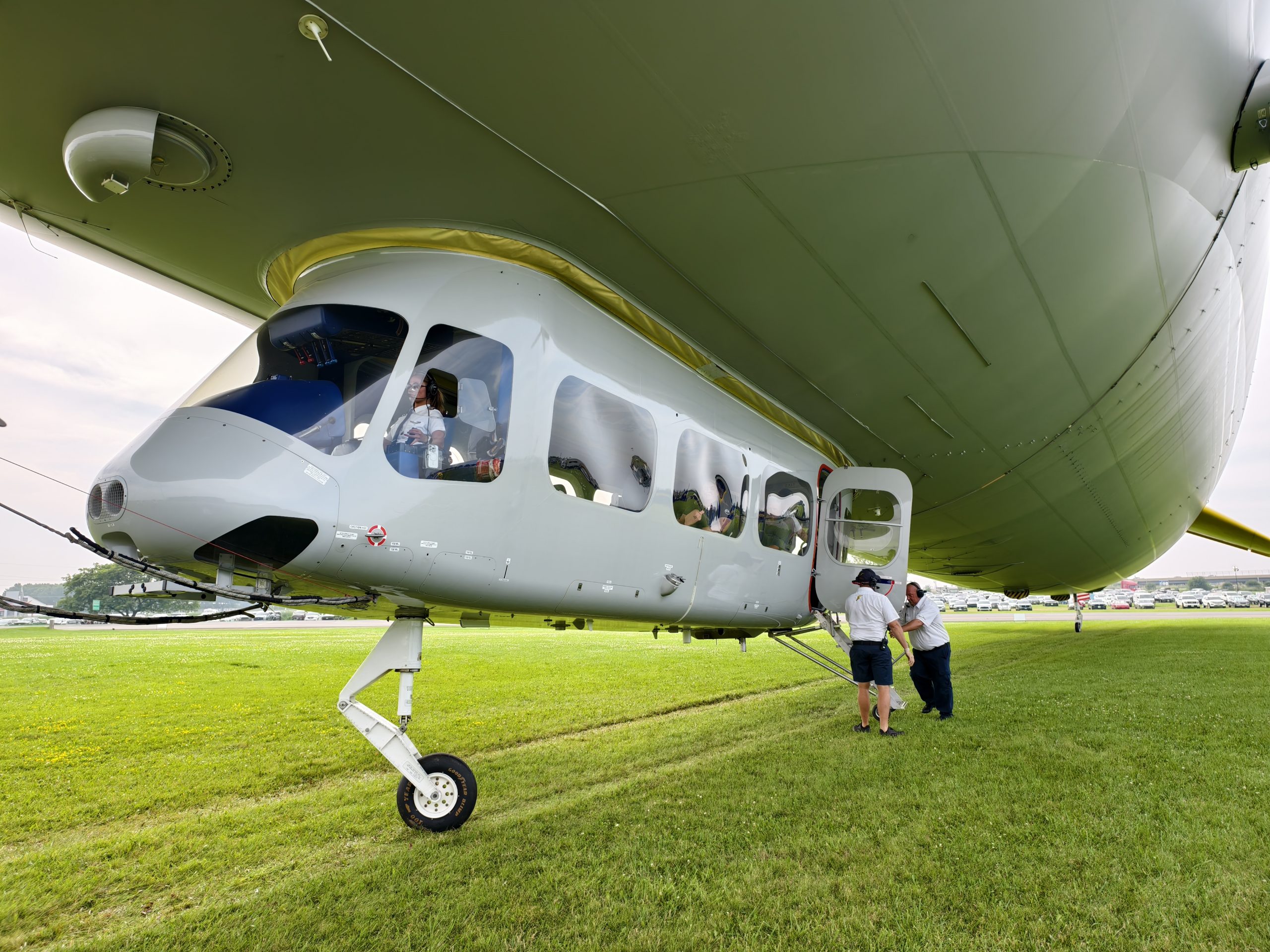
I’m told that these journeys are far from your average aircraft trip because Goodyear’s blimps stop the show wherever they go. The pilot told me that they’ll look down and see traffic pull over to get pictures. Often, the pilots will need to descend to a small airport in a town to fuel up, and sometimes, when this happens, the Goodyear Blimp becomes the talk of the town. Often, the blimp will make the front page story of a small town’s newspaper, too. Basically, the Goodyear Blimp and its crew are treated like rock stars.
Goodyear invited me to ride in Wingfoot One on July 25 during the show. This was a rare opportunity. Generally, Goodyear doesn’t carry the public in its blimps. Usually, if the blimps are carrying anyone, it will be Goodyear employees or maybe the press. Goodyear has carried the public before, but rarely. This includes AirVenture, where the closest 99.9 percent of attendees got to the blimps was taking a photo of one with their zoom lens.
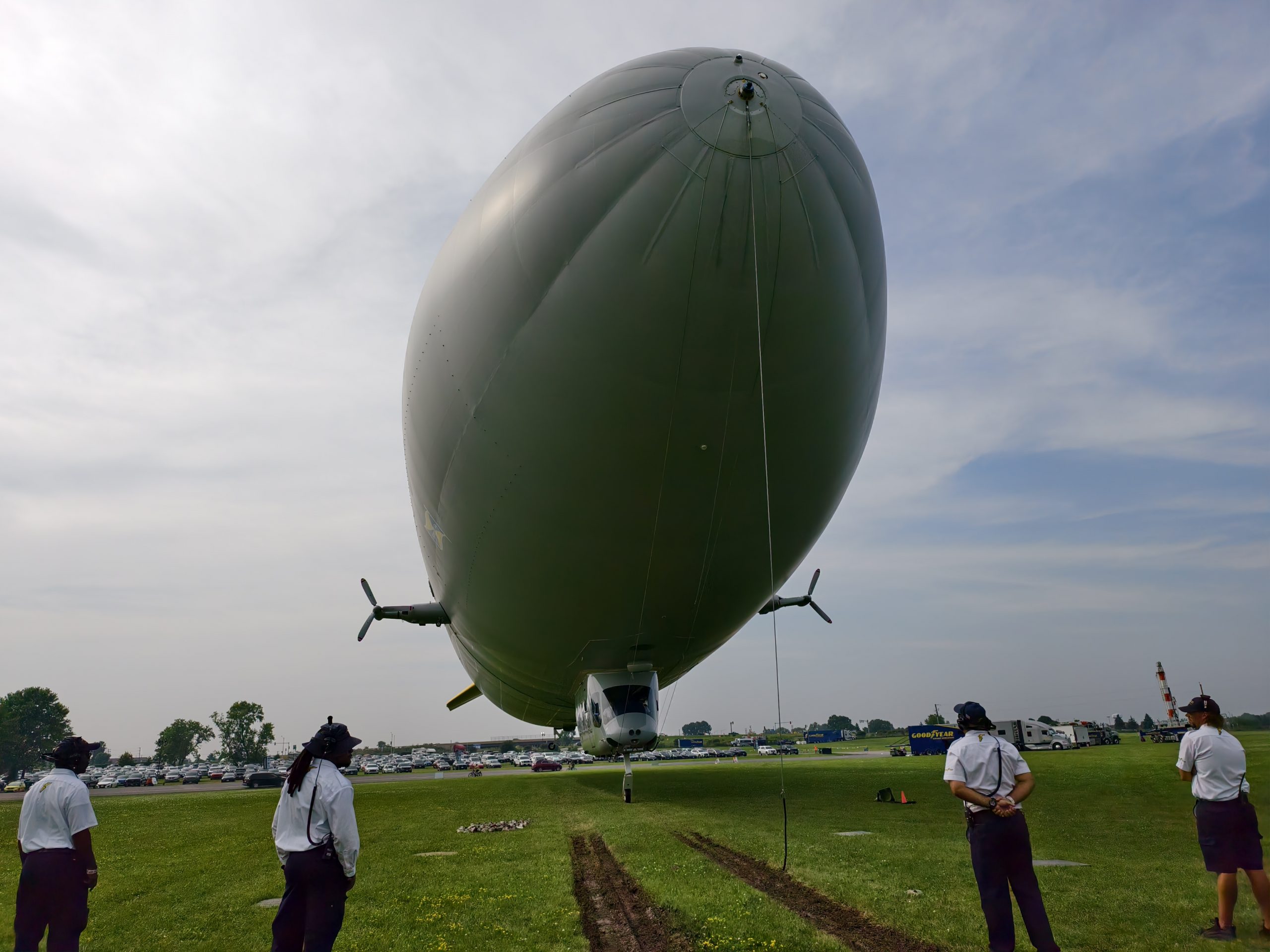

I was excited just to learn Goodyear was bringing two blimps to the show. My mind practically exploded when I discovered Goodyear’s invitation in my inbox. I’ve wanted to fly on a Goodyear Blimp since I was a kid, and I’m not sure I’ve ever responded to an email faster.
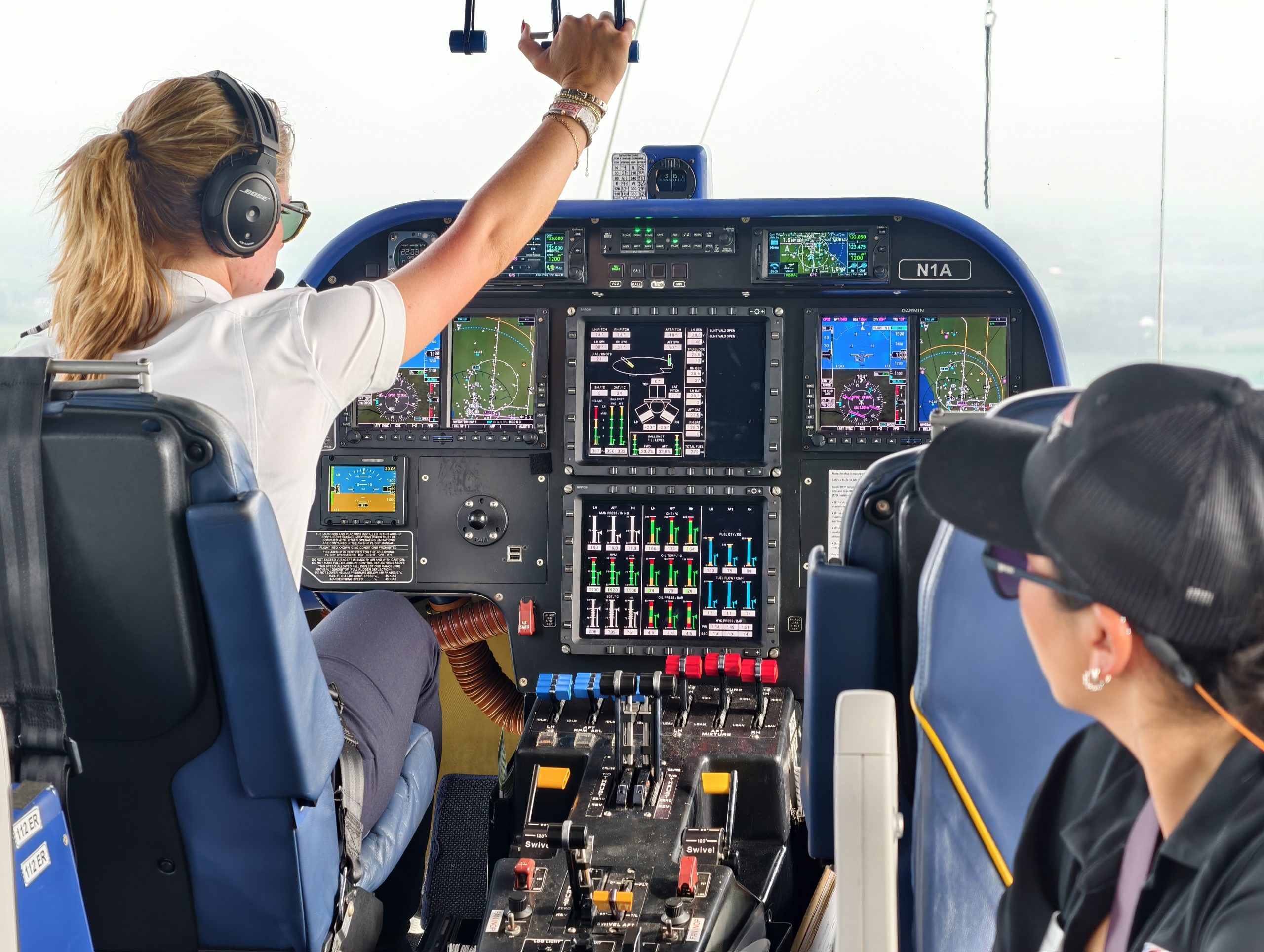
Riding in a Goodyear Blimp was as much about being starstruck as it was learning details of blimp operation that I had never considered before. One of the most surprising things I learned is that while airships are considered lighter than air, Goodyear actually flies its airship a little bit heavier than air. Wingfoot One was being flown at about 700 pounds heavier than air that day, with both ballast bags and passengers being used to weigh the airship down. I wondered why this was the case, and Goodyear’s pilot explained that it’s due to how blimps operate. If the blimp operated lighter than air, the pilots would have to constantly fight to keep it from floating away.
Using passengers as ballast also meant that the loading process was a bit entertaining. When a typical aircraft lands, everyone hops out and goes about their day. But that cannot happen here because if everyone got out, the airship would become lighter than air and float away. Thus, the loading/unloading process for a Goodyear Blimp is one person at a time. One passenger gets out, and is replaced by a new passenger boarding in. That way, the airship always has enough weight.
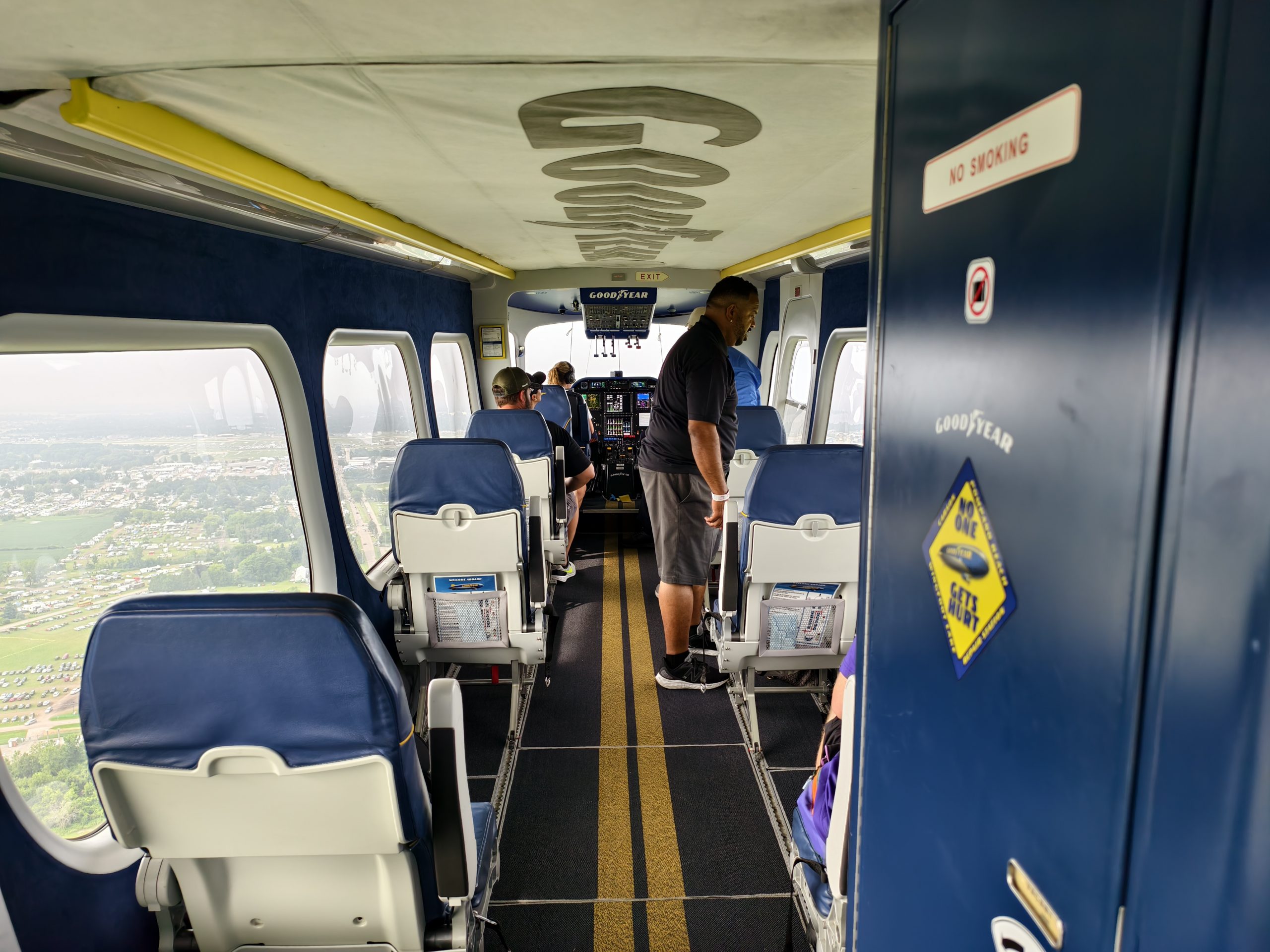
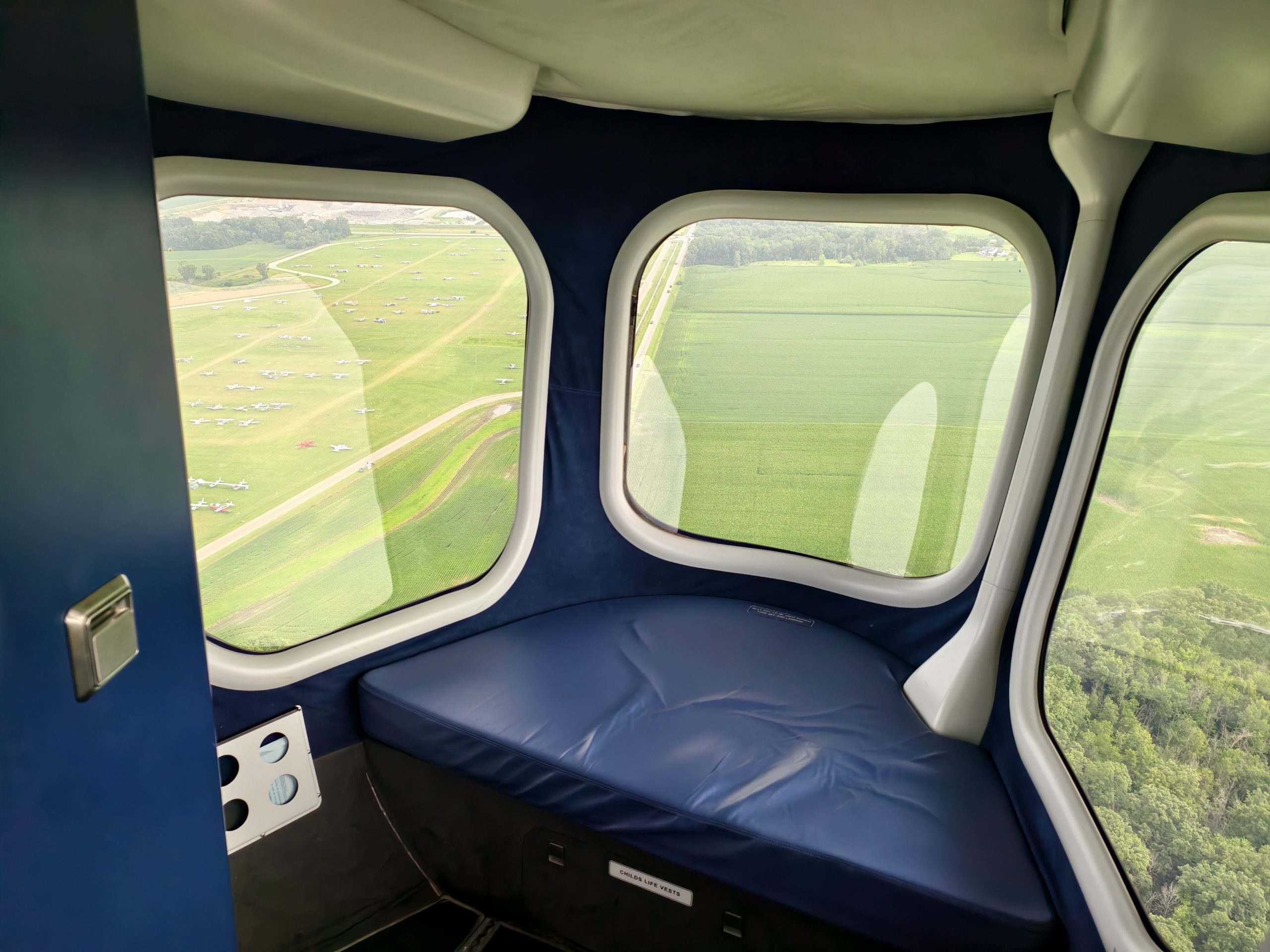
The way these airships “landed” was also interesting. Wingfoot One didn’t so much plant itself on the ground as touch the ground while still hovering. Like a boat, the airship still moved around while people were getting on or off of it.
The noise on the ground was tremendous as the three Lycoming engines were not shut down (a pilot was in the hot seat at all times to make sure everything was in control). I was shocked by how quiet it was once I actually got into the blimp. True to Goodyear’s word, having the engines high up on the envelope meant the cabin was nearly whisper-quiet. The cabin was also pretty much turbine-smooth, too – impressive since the blimp uses piston engines.
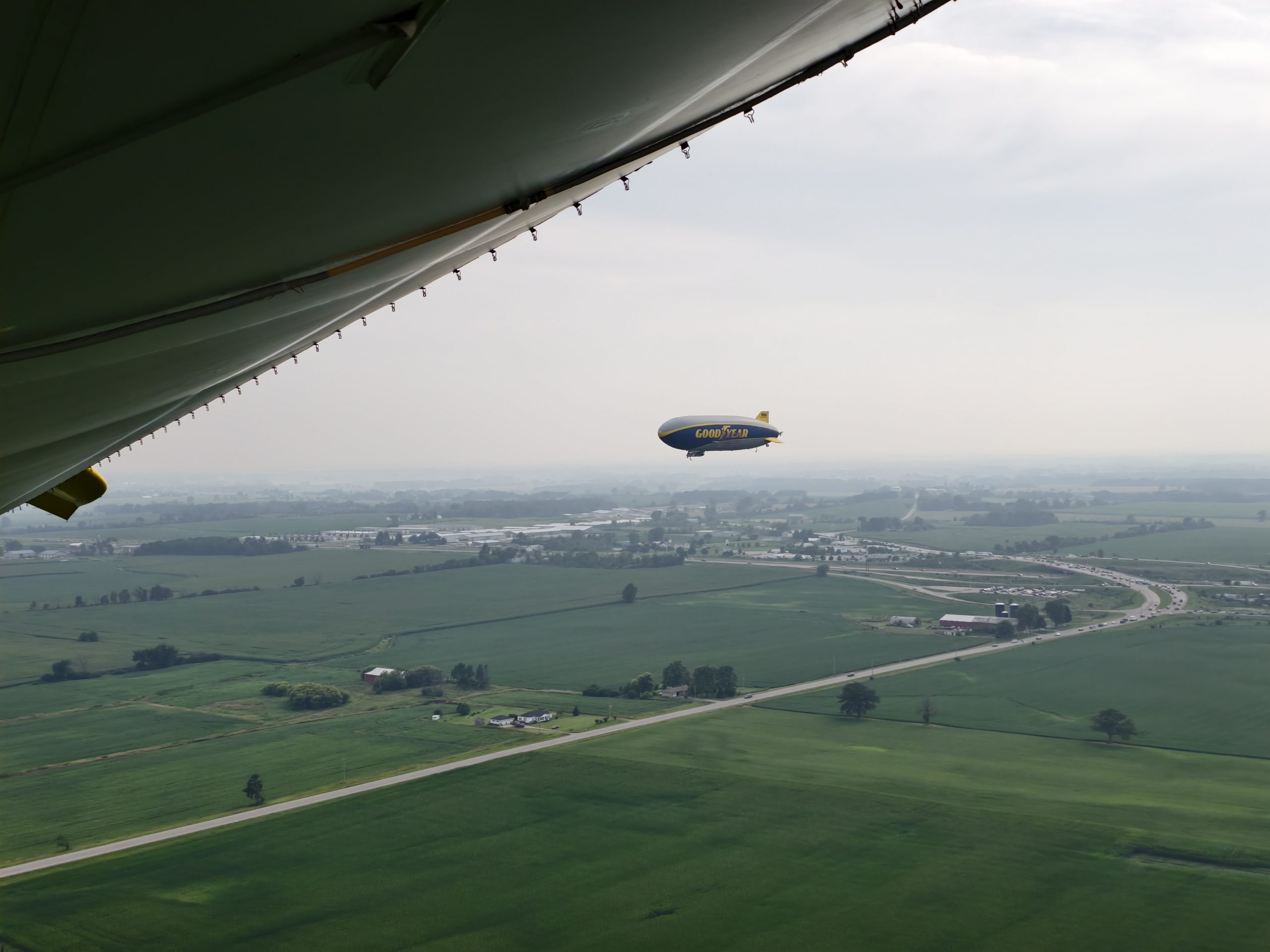
I was also surprised to see that the interior of the blimp was like that of a regional airliner, with skinny seats and tray tables plus a small lavatory. Unlike a regional airliner, however, there was a ton of headroom and legroom to spread out.
Once we were all loaded up, the blimp gently lifted off the ground and floated over the grounds at Wittman Regional Airport. The motion was similar to a helicopter taking off, but was smoother and infinitely quieter.
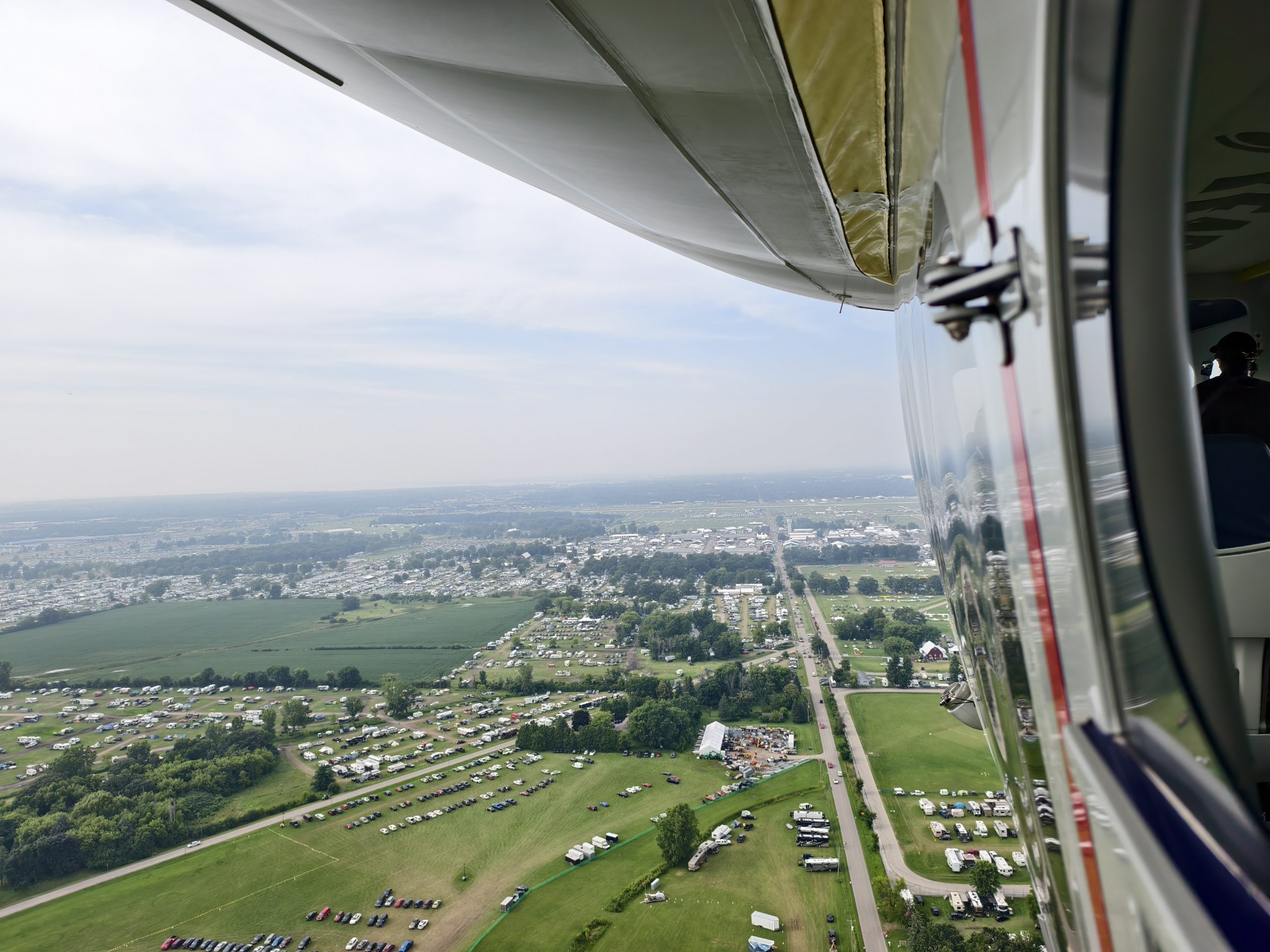
Once in the air, the first officer began explaining that he had decades of experience in fixed-wing aircraft before he transitioned to the blimps. I had to know just how a pilot ends up in a blimp, and he told me that it was actually sort of simple. He said blimps fly like a hybrid of a fixed-wing aircraft and a rotorcraft, explaining that when you’re flying forward, a blimp is controlled via its tail surfaces like a plane. Unlike a plane, blimps can hover and land vertically – like a rotorcraft. So, if you’re a pilot with a dream of flying a blimp, the transition apparently isn’t too difficult. The harder part will be finding opportunities to fly, as there aren’t many blimps out there.
The next surprising blimp trait I learned about was how they cruise. Blimps look like they fly pretty straight when you’re on the ground, but when you’re in the sky, it feels a whole lot like being in a small-ish boat out on a lake. The blimp gently rocks back and forth as it slowly moves through the sky. This is never really violent or anything; you just need to put your hand on the top of a seat as you meander through the cabin.
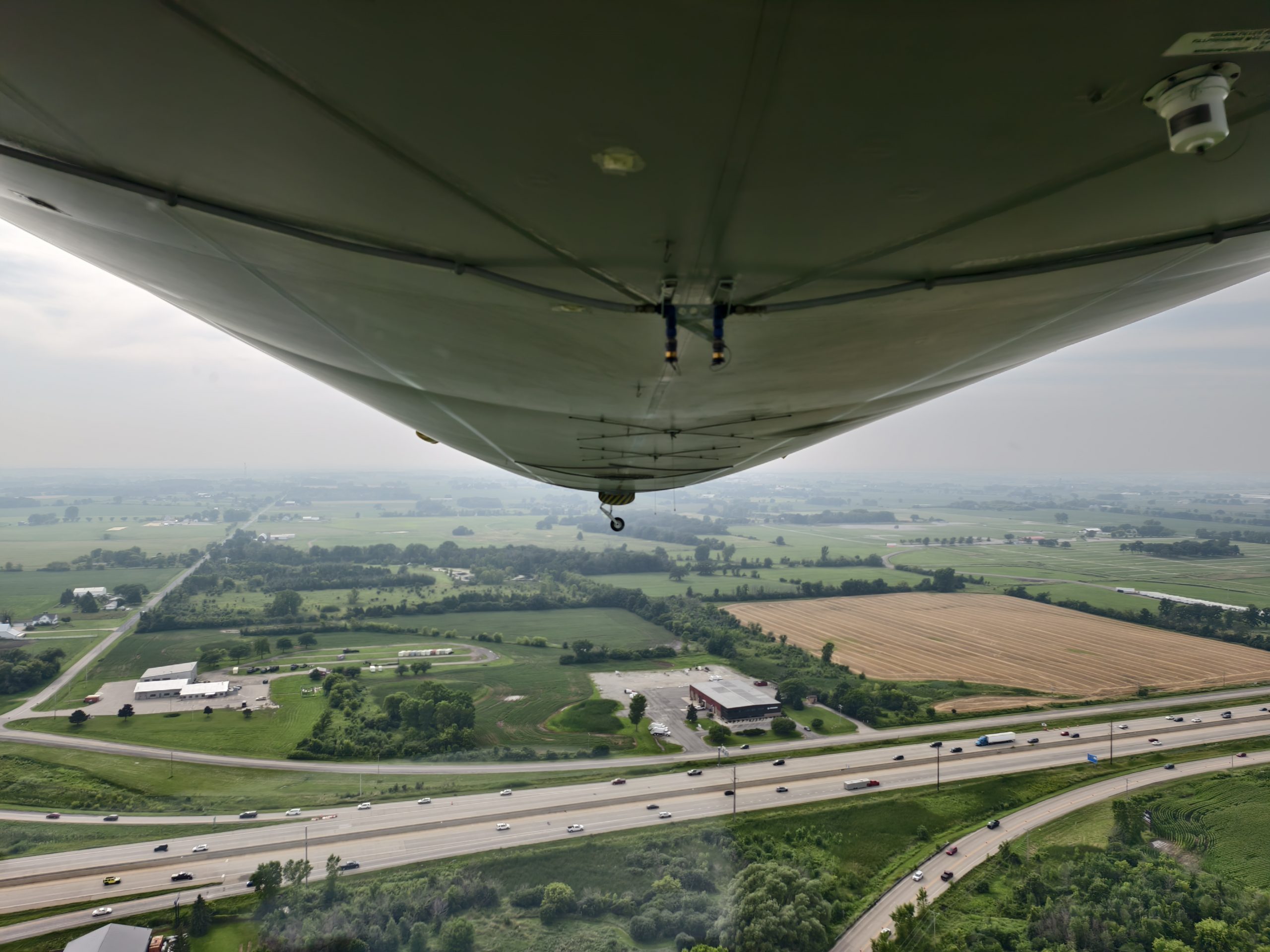
The blimp’s cruising speed of 40 mph also seems much faster when you’re in the air. Sure, 40 mph is nothing when commercial jets can tear across the sky at 600 mph, but it isn’t the slow motion you think it is when you’re on the ground. The other neat thing is that airships settle into quite a gentle cruise. Once you’re flying, you sort of just point it in the direction that it needs to go, and it smoothly rocks its way through the sky.
However, the pilot noted, flying in less-than-perfect conditions can be fun. These airships can’t fly in heavy winds and storms are pretty much a non-starter. The engines do help tremendously. Even as winds picked up at AirVenture, the blimps remained in control of their skilled pilots.

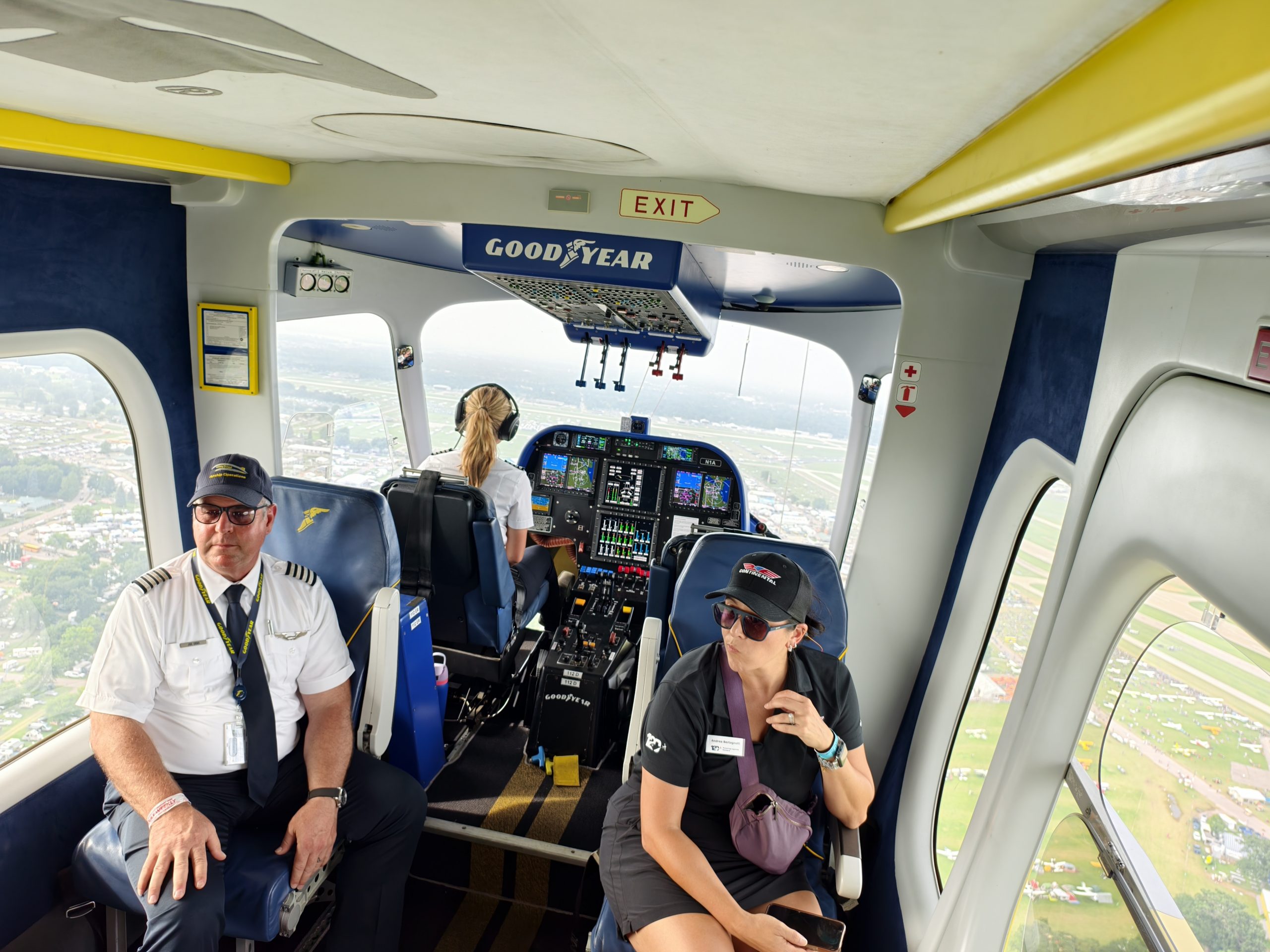
There isn’t much luxury in the blimp. There’s no air conditioner, no entertainment, and nowhere to plug in a mobile device – which makes sense, since the blimps don’t carry the public and all of that stuff would add weight. That said, the blimp does have windows that open.
The flight deck was probably the most fascinating part for me. I expected a sort of simple affair like what you’d see in a Cessna 172. Instead, the flight deck more closely resembled that of a commercial airliner, with screens showing engine data, engine rotation, and other information. The screens also displayed fuel load, an artificial horizon, and all of the other bits you’d see in a larger aircraft.
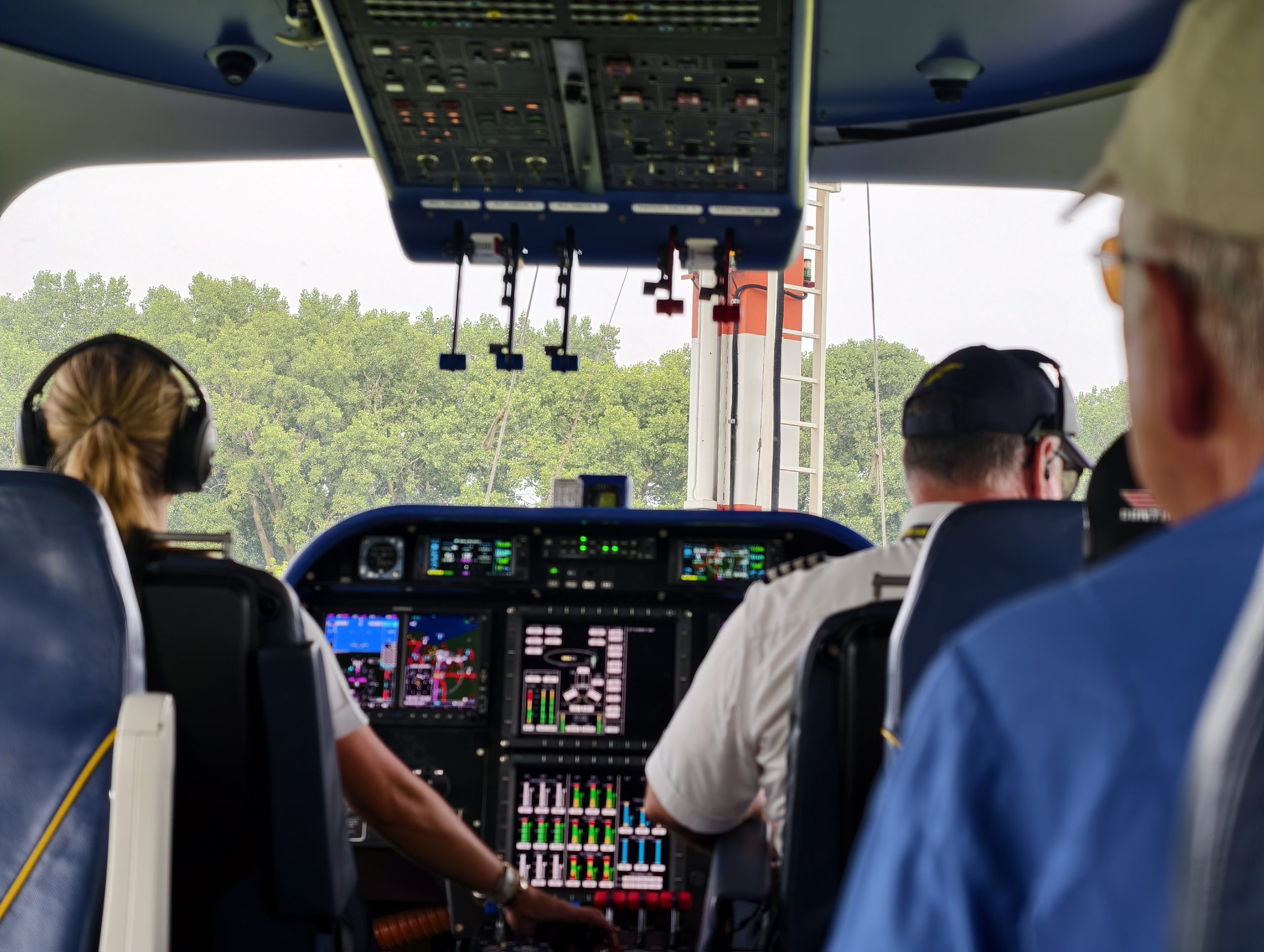
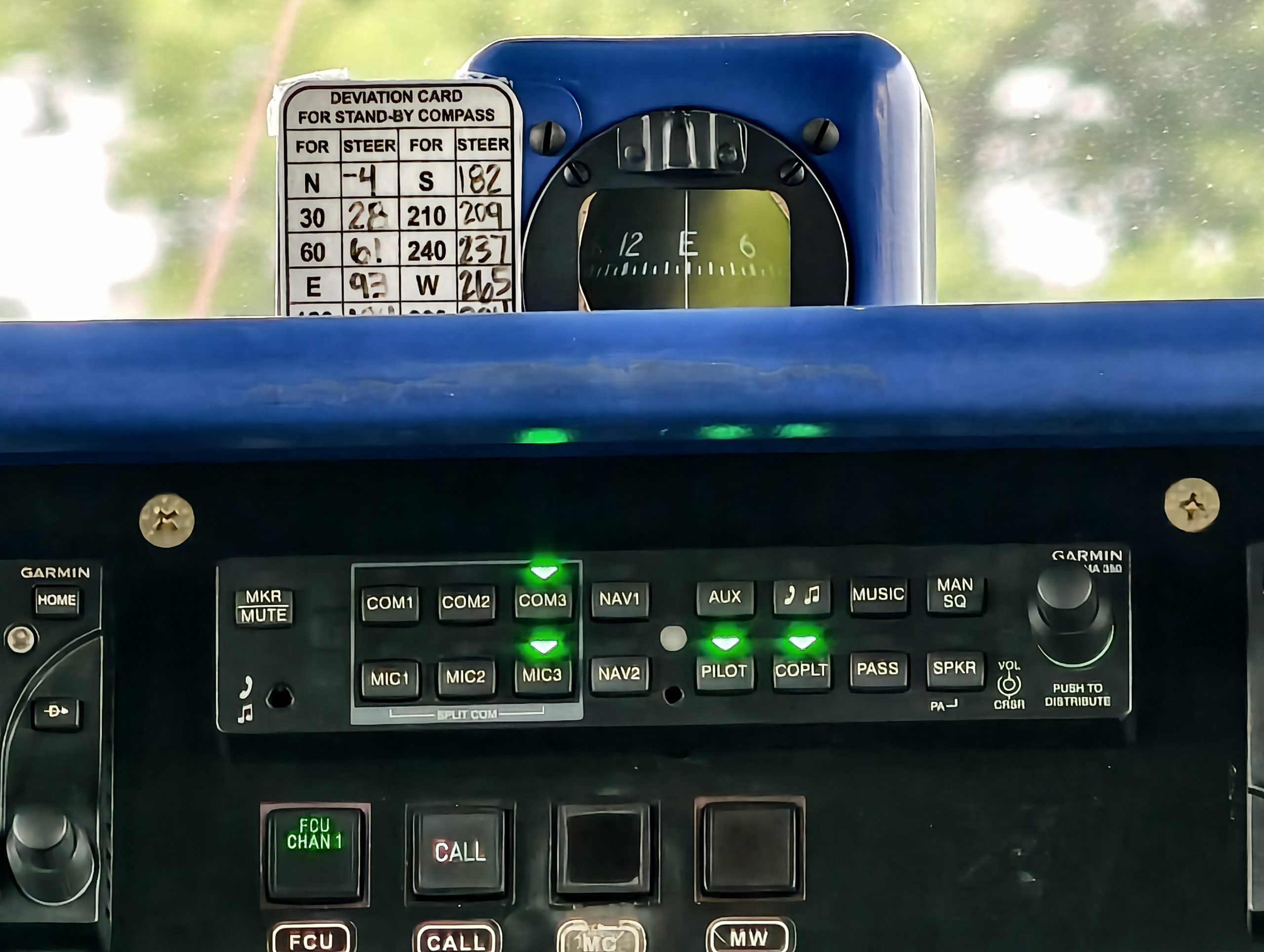
The levers were similarly useful with throttle quadrants, levers to rotate the engines, and levers to adjust the fuel mixture. Pretty much everything that you’d expect to see in a flight deck was there, but all airship-ified. Pitch is affected through use of the engines, as well as transferring fuel forward and aft, and through shifting the contents of the ballonets (air bladders). When done well, such as in the case of my flight, the passengers feel basically nothing but easy flight.
Something fascinating happened during my flight, and it was that the pilots had to land to take on fuel. This made a special experience even cooler because I got to watch the docking process of the blimp.
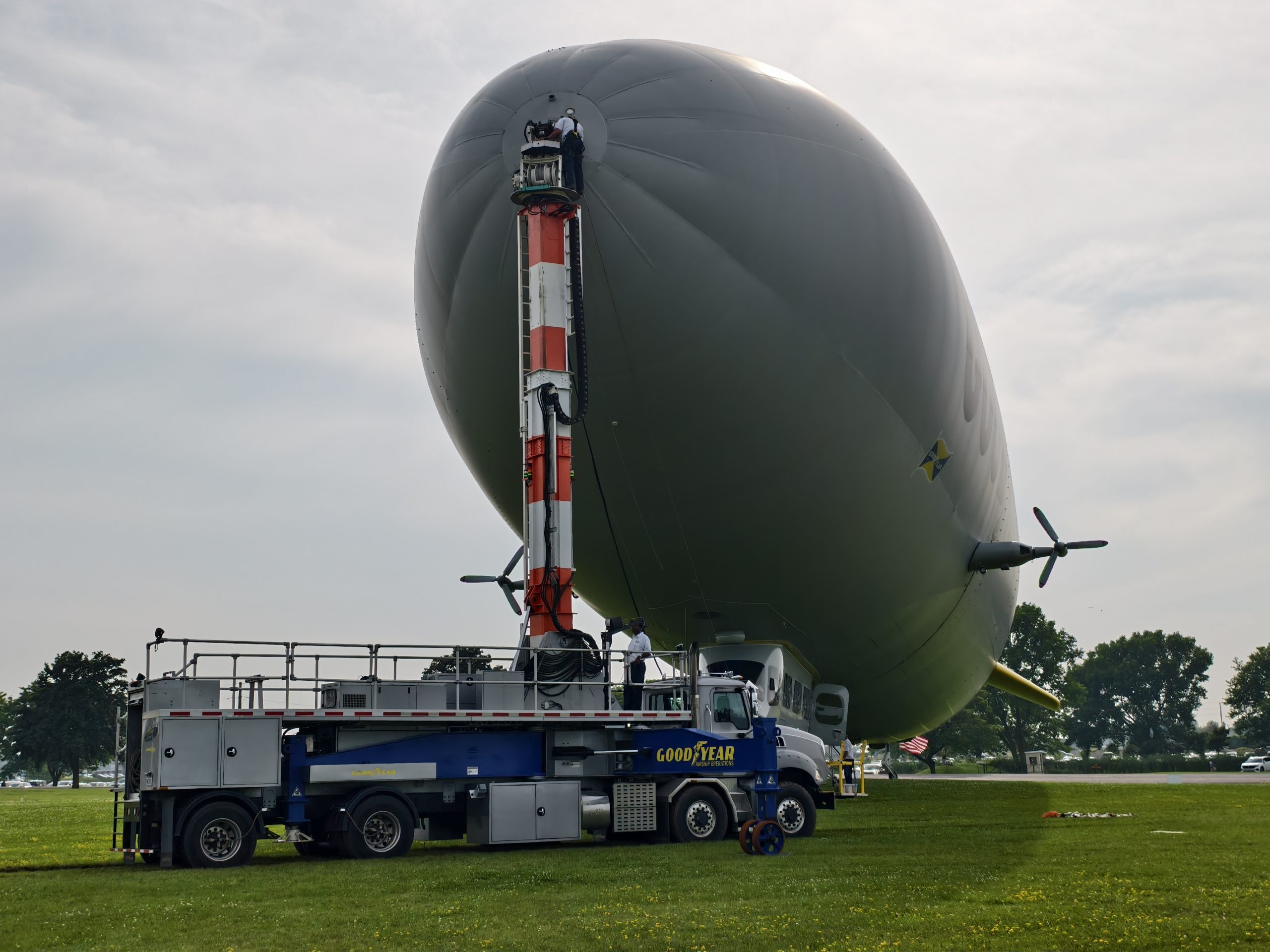
Goodyear brought two of its 63,500-pound, 12-wheeled Mack-based mast trucks to Oshkosh. These trucks not only serve as secure parking zones for the airships, but they also feed the airships fuel. To dock with a mast truck, a line is first cast out and then winched in by the truck. As the truck pulls the airship in, the pilot blasts the engines in full reverse. This ensures the airship doesn’t collide with the mast truck.
The pilot described this as a sort of fight, one where the truck wins every time. Once the docking process is complete, the engines wind down, and fuel is pumped into the airship. In our case, Goodyear’s airship operations team also ran out to the blimp and filled its hold with cases of ballast, allowing everyone to leave the blimp at the same time without it floating away.

After I disembarked, I learned some more interesting facts about Goodyear’s blimps. The lifespan of the envelope is under 15 years or so. Goodyear says that, sometime before 2030, Wingfoot One will have to land, get its helium lift gas removed, and then have its envelope replaced. It’s during that time that the airship will weigh 20 tons, and it’ll probably look pretty weird with the envelope deflated and removed.
Sadly, my flight in a Goodyear Blimp ended sooner than I wanted it to. I was having the time of my life! It could have only been better if they had let me take a shot at the controls. CNN got a chance to actually fly it, so maybe I might be able to one day, too. Until then, this was still a dream come true.

Flying in the Goodyear Blimp was romantic in the same way that riding aboard a vintage train is. It’s slow, quiet, personal, and just an overall gentler way to travel. So many people, myself included live life at full throttle, jetting all over the place and moving onto the next thing before you even have time to absorb what just happened only moments before. A blimp forces you to slow down and relax in ways that too many people don’t.
One of the more fascinating parts of this story is that, while airships are arguably obsolete, Goodyear has found an excellent way to keep them popular. Sure, you’re never going to take a commercial flight in a blimp anytime soon, if ever, but they still capture the eyes and hearts of millions. Of course, I reckon these airships are also pretty great at selling tires, too.








Having followed Mercedes for years now this a trip of a lifetime for her, glad to see her dream realized
PS, just for the record, I’ve figured out how to delete my own comments when I’m on an alcohol influenced lonely old gay guy rant and shouldn’t post some things. Please forgive me for some past comments I’ve posted.
You’re forgiven, Sofonda! No hard feelings, I promise! <3
Oh my Goodness, Mercedes, I’m jealous! Have you ever been on a hot air ballon journey, If so, how did this compare? I’ve done one in the past and it was great until we got closer to land. I was truly scared shitless and couldn’t get out of that big wicker basket fast enough when we hit land. Just for the record, some folks find some of my comments controversial (snowflakes) but please know that your my favorite contributor on the Autopian and the reason I don’t just do the free version and subscribe. I want to make sure that they can pay you for your awesome writing talent. And hey, I’ve looked up Cheryl and she does some amazing things looking out and defending the little guys and can see why you adore her like you do. I’m gay and don’t quite get the whole trans thing, but I do appreciate your transparency on the matter and helping this old queen find understanding about it all. You, keep being your awesome talented self and keep posting these amazing articles my dear.
Sounds like a good day!
Wow, this is so awesome! Glad you had so much fun
So the Germans led zeppelin development in the 30s?
Yes, you might even say they had a whole lotta luft
As a commenter who is very definitely not a cephalopod piloting a zeppelin, I nevertheless approve of this and request further Zeptopian content.
I have a fear of flying after a bad experience as a teen (emergency landing with fire trucks and the lot). But I would totally do this as a bucket-list item.
And a friend is such an aviation nerd I would help him get this opportunity if I could.
I think you got your subject and object reversed, or “the blimps remained UNDER control…”
Just gonna say it here, but we’re all madly jealous of Mercedes taking a flight on the Goodyear Blimp. We’ve all wanted to do that too.
We see those Goodyear Blimp in Germany as well. This one flew over Olympic Park, BMW Welt, and BMW headquarter and manufacturing plants in Munich.
By the way, Boeing 747-8 doesn’t need the extra zeros as Airbus A380-800 does.
Big Blimp’n press say cheese,
She be tha, Mer-ce-des, up high with da V-I-P’s.
BLIMPIN AINT EASY deserves some credit
The origins of the name “blimp” are certainly not known. Mercedes provides a couple of possibilities. I once watched a documentary on blimps and they also stated that it’s origin is unknown. The theory they presented was it might have been a combination of type “B” aircraft that can become limp. They combined B with limps and came up with Blimps. Who knows? PS Mercedes, Matt has a nice picture of a blimp. Ask him.
That, or when you let all the gas out of them, they “be limp.”
I finally got to see one in person at the Chicago NASCAR race, and I finally got the allure. I mean, I’ve always thought blimps/zeppelins were cool, but I wasn’t particularly enamored with them until I saw one in real-life, three-dimensional space. Super cool.
Incredibly jealous! At least you wrote it up to share 😀
I guess they no longer make zeppelins out of led.
Serious question: is the ceiling of the gondola merely the exterior of the superstructure? I guess sharp objects are verboten onboard.
I forget the title and author, but about 20 years ago I read a memoir by a junior engineer at Goodyear-Zeppelin who talked about building and flying them, and meeting Hugo Eckner.
On a personal note I used to work near Hillsboro airport and see the Fuji Film blimp, built and operated by American Blimp, Goodyear’s rival in the airship biz.
With all that surface area and slow speed, I bet enough solar could be integrated into the design where it could run on electricity most of the time and just have the piston engines as a backup.
Not quite, but it is a romantic idea.
The blimp currently has a total of 600 hp combined which would equal 447 kw. It takes roughly 100sq ft of solar panels to generate a kw under ideal conditions which means you would need 44,700 square feet of solar panels, which is a little more than an acre. The blimp would need to be at least 447 feet long by 100 feet wide in order to accommodate those panels which is a whole lot larger than the current blimps.
Solar panels also add weight, a flexible solar panel is about 4lbs per 100w so you’re going to need to lift an additional 18,000 lbs in solar panels. I have no idea how much more helium would take to lift all those panels.
We could always re-write the laws of physics.
I love this so much. I’ve always been curious about airships. Great history and review of the flight!
When I was finishing my bachelor’s degree a few years ago, I had to identify an issue with aviation and I had just started my new role as an operations analyst. The thing in my company that causes the most heartburn is moving oversized loads over the road. So I picked that as the problem and started digging into options and one that stood out was airships. The soviets had actually designed and built and tested scale models of an airship capable of airlifting entire rockets. It’s led to some good conversations at work.